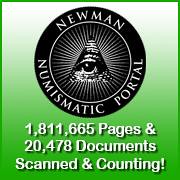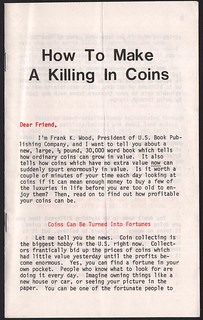
About UsThe Numismatic Bibliomania Society is a non-profit organization devoted to the study and enjoyment of numismatic literature. For more information please see our web site at coinbooks.org SubscriptionsThose wishing to become new E-Sylum subscribers (or wishing to Unsubscribe) can go to the following web page link MembershipThere is a membership application available on the web site Membership Application To join, print the application and return it with your check to the address printed on the application. Print/Digital membership is $40 to addresses in the U.S., and $60 elsewhere. A digital-only membership is available for $25. For those without web access, write to: Terry White, Treasurer AsylumFor Asylum mailing address changes and other membership questions, contact Terry at this email address: terrywhite5475@yahoo.com SubmissionsTo submit items for publication in The E-Sylum, write to the Editor at this address: whomren@gmail.com BUY THE BOOK BEFORE THE COINSale Calendar
|
- WAYNE'S WORDS: THE E-SYLUM JUNE 10, 2018
- KOLBE & FANNING OFFER ADAMS ELDER CATALOGUES
- NEW BOOK: DUTCH EAST INDIES PLANTATION TOKENS
- NEW BOOK: BANKNOTE BOOK: MADEIRA
- BOOK REVIEW: SAINT PATRICK COINAGE
- DIX NOONAN WEBB CATALOGS ON NEWMAN PORTAL
- KEN BRESSETT REMEMBERS WHITMAN COIN HOLOGRAMS
- SILVERTOWNE SLABS
- NOTES FROM E-SYLUM READERS: JUNE 10, 2018
- HOW TO MAKE A KILLING IN COINS
- VOCABULARY TERMS: UNIFACE AND SINGLE-SIDED
- GILBERT WILLIAM GILL (1838-1910)
- SELECTIONS FROM THE FRANK ROBINSON JULY 2018 SALE
- SELECTIONS FROM THE JUNE 2018 EARLY AMERICAN SALE
- SEARS MARYLAND LOTTERIES RESEARCH COLLECTION
- SINGAPORE TRUMP-KIM SUMMIT COMMEMORATIVE COINS
- TEC CREATES ERIC P. NEWMAN ELONGATED COINS
- WELLINGTON PIT DISASTER EDWARD MEDAL
- THE YUKON MINT KASKA GOLD COIN
- ANA REDESIGNS 2018 PHILADELPHIA MEDAL
- BIRMINGHAM WASHINGTON CENT REPLICAS STRUCK
- HOW THE RAILROAD WARS SHAPED FINANCE TODAY
- WWII CASH HOARD FOUND
- WHERE IS BEALE'S TREASURE?
- MOVIE MEMORABILIA: FAKES AND AUTHENTICATION
- BOOKSELLERS ADAPT TO THE 21ST CENTURY
- THE MAN WHO WANTED TO BE A COIN
- IN OTHER NEWS: JUNE 10, 2018
Click here to access the complete archive a
Click here to unsubscribe (scroll down)
To comment or submit articles, reply to whomren@gmail.com
Content presented in The E-Sylum is not necessarily researched or independently fact-checked, and views expressed do not necessarily represent those of the Numismatic Bibliomania Society.
WAYNE'S WORDS: THE E-SYLUM JUNE 10, 2018
 New subscribers this week include: Steve Rye. Welcome aboard! We now have 5,772 subscribers.
New subscribers this week include: Steve Rye. Welcome aboard! We now have 5,772 subscribers.
Thank you for reading The E-Sylum. If you enjoy it, please send me the email addresses of friends you think may enjoy it as well and I'll send them a subscription (but let me know if they are located in the European Union). Contact me at whomren@gmail.com anytime regarding your subscription, or questions, comments or suggestions about our content.
This week we open with more from the Kolbe & Fanning sale of highlights of the John W. Adams library, two new books, one review and an update from the Newman Numismatic Portal.
Other topics this week include Whitman's coin holograms, Silverowne's "slabs", Charles Geekie, collector G. W. Gill, highlights from the Robinson and Early American sales, Trump-Kim summit coins, Washington Cent replicas, early lottery tickets, and Beale's treasure.
To learn more about the 1907 J.B. Chase sale, Netherlands East Indies plantation tokens, Portugal's Casa da Moeda banknotes, Saint Patrick coinage, How to Make a Killing in Coins, uniface medals, the second King of Siam Proof Set, Uncle Sam's Change, and the Man Who Wanted To Be A Coin, read on. Have a great week, everyone!
Wayne Homren
Editor, The E-Sylum

KOLBE & FANNING OFFER ADAMS ELDER CATALOGUES
FROM THE JOHN W. ADAMS LIBRARY
TO BE OFFERED BY KOLBE & FANNING
July 14, 2018 Sale Includes Nearly All of Elder's Very Rare Plated Catalogues
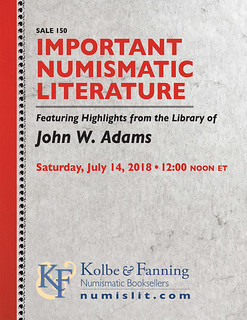 Kolbe & Fanning Numismatic Booksellers are celebrating our 150th Auction by offering highlights of the John W. Adams numismatic library on July 14, 2018.
Kolbe & Fanning Numismatic Booksellers are celebrating our 150th Auction by offering highlights of the John W. Adams numismatic library on July 14, 2018.
The Adams Library includes one of the finest collections of American numismatic auction catalogues ever assembled. Among the extraordinary offerings are the catalogues of Thomas L. Elder.
Tom Elder believed strongly that coins had to be appreciated within their historical context, and gravitated toward those areas of Americana where such context was most obvious: tokens and medals, especially political pieces. He also had a finer appreciation of antiquity than did many of his generation, with ancient Greek and Roman coins frequently appearing in his sales. While his best-known sales are usually most important for their American offerings, there are exceptions, such as his 1920 Henry C. Miller sale, which is highly important for its Roman silver coins and early English pieces, as well as for the Connecticut coppers for which Miller wrote the standard reference. The Adams Library features a nearly complete run of Elder catalogues, including almost all of his plated catalogues.
A few particularly noteworthy Elder catalogues include:
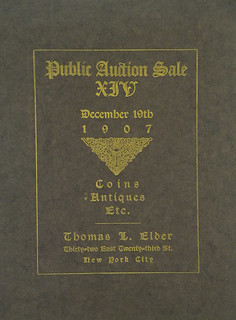
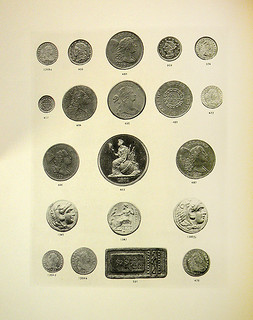
Lot 127
--Lot 127: the extraordinarily rare J.B. Chase sale (1907) with photographic plates

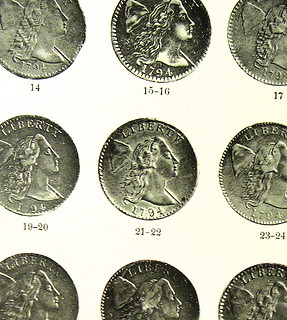
Lots 133 and 137
--Lot 133: an extremely rare plated copy of Elder's Sale 37, featuring fine, full-tone photographic prints depicting U.S. pattern, regular issue, and private coins, as well as foreign and ancient coins.
--Lot 137: the 1910 Ebenezer Gilbert sale, in original state with plates
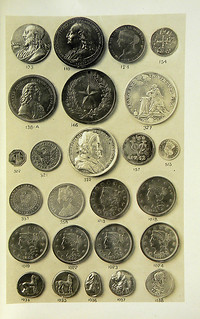
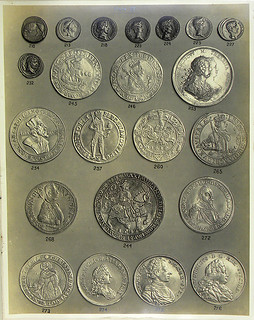
Lots 161 and 164
--Lot 161: the very rare Wright-Person sale with five photographic plates
--Lot 164: the “Private Collection” with 14 superb plates
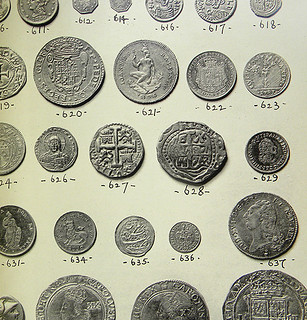
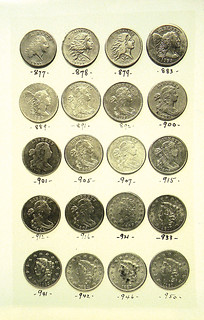
Lots 166 and 169
--Lot 166: a superb Craig Clare sale with thirteen photographic plates
--Lot 169: a copy of the Lewis C. Gehring sale with photographic plates
--Very rare plates for Elder’s 34th sale, 36th sale, and his 1926 sale of the G.W. Lee collection of large cents
--Nearly every other plated Elder sale, including: Virgil Brand’s copy of Elder’s first plated sale; the 1908 Gschwend sale; the James B. Wilson sale of the same year; the 1910 Peter Mougey sale; the 1911 William H. Woodin sale; Elder's Sale 66, held in September 1912 and featuring two plates of ancient Greek coins; two plated copies of the 1917 Henry Miller large cent sale, one of them S.H. Chapman’s bidbook; the 1917 George C. Carlton sale; Lyman Low’s copy of the Hewitt & Bartlett catalogue; the McCoy, Brown, Ezekiel sale; the 1920 Miller sale; Elder's own copy of the 1921 McMullin sale; the very rare Lynch, Walker & Tilden sale; and the Dr. George Alfred Lawrence sale.
--Rare unplated catalogues missing even from most advanced collections of Elder sales, including: his very rare 1903 mail-bid sale held in Pittsburgh; Sales 89, 97, and 158; the famously rare series of five "small beer" sales of 1915 (Adams 107, 109, 113, 115, and 116), some of which we are offering for the first time ever.
The extensive, full-color catalogue is now available at bid.numislit.com. The sale will feature live online bidding using Kolbe & Fanning’s custom third-party online bidding platform. Printed catalogues will be mailed to established customers. Bidders wishing to make an appointment to view auction lots are invited to contact David Fanning at df@numislit.com.
Kolbe & Fanning Numismatic Booksellers LLC is a licensed and bonded auction firm in the State of Ohio. For more information, please see the Kolbe & Fanning website at numislit.com or email David Fanning at df@numislit.com
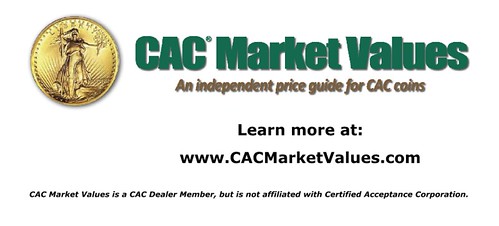
NEW BOOK: DUTCH EAST INDIES PLANTATION TOKENS
Author : A.J. Lansen & M.L.F. van der Beek
 This, joint, new English publication of the plantation money in the former Netherlands East Indies is an improved version of the, in 2001, published book , on the same subject, with the title : “Plantation-,
Merchant-, and Mining Money of the Netherlands East Indies”, by A.J. Lansen & L.T. Wells jr. In this edition is a description of 354 tokens, with a lot of interesting new details, including 29 new items and 6 new
unmentioned estates.
This, joint, new English publication of the plantation money in the former Netherlands East Indies is an improved version of the, in 2001, published book , on the same subject, with the title : “Plantation-,
Merchant-, and Mining Money of the Netherlands East Indies”, by A.J. Lansen & L.T. Wells jr. In this edition is a description of 354 tokens, with a lot of interesting new details, including 29 new items and 6 new
unmentioned estates.
Each token is identified by its denomination, shape ,size, weight, metal composition and die axis position. Insofar as possible, an illustration has been provided.
The book has an introduction in Dutch and English, followed by a geographical list of metal token issuing estates and companies during a specified issuing period.
The catalogue is in English. In the description of the tokens is a reference- indication- number given of the 2001 edition of Lansen & Wells ( La/We)
In a supplement is a description of 3 Dutch-English estates with settlements in British North Borneo. At the end is a concordance compilation with the new numbers of this revised edition, the Lansen/Wells numbers and the C. Scholten numbers.
The authors hopes that this book, compiled after many years of intensive scientific research, get the interest of many collectors and numismatists.
Technical data:
Book format: A4; hardcover, pages: 178, illustrations: colour. Private-publication, on one’s own account. Price: 29,50 Euro, excluding shipping costs. Prepaid payment: by cash or bank account : NL38ABNA 0621998699 to: A.J.
Lansen e/o IJsselstein, The Netherlands. Postal address: A.J. Lansen Haanderik 94 3401 ET IJsselstein. The Netherlands. Mail to: ajlansen@caiway.nl .
In the course of the second half of the nineteenth century, private companies in the Dutch East Indies began to issue their own means of payment for use on their estates. Metal tokens were issued from c.1870 on, and paper notes printed from c. 1890. Th.e heydays revolved around the turn of the century and lasted for about twenty years, although some series date from the later period 1900-1915. Most estate money originated and circulated in areas of the east coast of Sumatra.
Th.e main reason to issue these means of payment was a shortage of silver coins in the estate zones. Many of these estates, especially on the east coast of Sumatra, were situated in areas barely protected by the Dutch authorities in the 1890s. Hence, silver money for salary payments was only occasionally available. But when it was, it posed a serious risk to the companies using it to make payments. Other reasons also played a role. .The plantation workers were paid in legal tender money only at the end of their contractual period. .The plantation currency they received in the meantime on a monthly basis served as a small advance they could use for their daily expenses. In addition, it also contributed to ensuring that they would not prematurely leave the estate. .The often-heard complaint that it was enforced on them knowing they could only spend it in shops on the estate itself, has little validity; in the remote rural areas this was anyhow the case, even on estates which issued no tokens.
Estate Money of the Dutch East Indies was first described in two catalogues of the collection of the Bataviaasch Genootschap van Kunsten en Wetenschappen published in Batavia in 1886 and 1896. In the 1886 edition, only 25 paper notes from 8 issuing companies are reported, together with 8 metal tokens and 4 Javanese tokens made from bamboo; in the second edition of 1896, already 261 paper notes issued by 92 companies are reported, together with a large number of metal tokens, approximately 200 pieces.
C. Scholten’s Munten van de Nederlandsche gebiedsdelen overzee (1951) contains a list Particuliere munten van de ondernemingen in Nederlands-Indië, with the metal tokens known to him. W.W. Woodside made a survey in his handwritten Catalogue of East Indies Estate Tokens (1963), which also mentions means of payment made of bamboo and paper.
In 1992 I published my own inventory, in which all the then known metal tokens were described. It was followed, in 2001, by the book I wrote together with L.T. Wells (hence referred to as the ‘LaWe’): Plantage-, Handels- en Mijngeld van Nederlands-Indië, which has since become the standard reference. Some metal tokens are also mentioned by other authors, i.a. by P. Menzel, Deutschsprachige Notmünzen und Geldersatzmarken im Ausland. Band III (1997), by Jerry F. Schimmel, German Tokens Part II Colonial Issues, Austria, Luxembourg, Switzerland and other Areas (1988), and by Saran Singh, The Encyclopaedia of the coins of Malaysia, Singapore and Brunei (1996), and most recently in the catalogue of the exhibition Oeang, ruil- en betaalmiddelen in Indië, organized at the Bronbeek Museum on the occasion of the 300th meeting of the Numismatische Kring Oost-Nederland in 1999.
Due to the rarity of these tokens, however, a lot of things remained unclear or were missing from the aforementioned publications. The weights of the tokens have never been published systematically, and neither have their sizes. And a pilot study by the author of the metal composition of some token series showed that the alloys in many cases differ from what was hitherto assumed. It so appeared that tokens supposedly made of nickel, copper-nickel and bronze, did not at all occur in the Dutch East Indies series, whereas the most common so-called ‘white metal’ tokens are actually made in ‘german silver’ (or alpaca, an alloy of copper, zinc and nickel).
These findings have led to a large-scale investigation into the estate tokens present in a dozen of the most important collections, both national and international, as well as those of the former Geldmuseum in Utrecht (now curated by De Nederlandsche Bank). In addition, numerous data have been obtained by corresponding with many collectors worldwide. The 850+ tokens have all been measured, weighed and photographed, and each alloy has been analyzed by means of X-ray 9uorescence (XRF).
NEW BOOK: BANKNOTE BOOK: MADEIRA
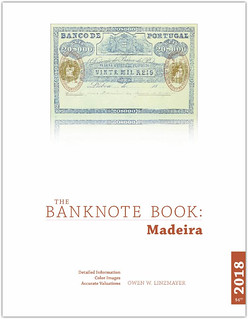 I'm pleased to announce the Madeira chapter is now available for individual sale at US$4.99, and as a free download to subscribers.
I'm pleased to announce the Madeira chapter is now available for individual sale at US$4.99, and as a free download to subscribers.
Madeira (Europe)
This 7-page catalog covers notes issued by the Banco de Portugal (Bank of Portugal) from 1875 to 1891, and the Casa da Moeda (Mint) in 1892. Published 08.06.2018.
For more information, or to order, see:
http://www.banknotenews.com/
Owen writes:
That's because Madeira is a tiny island colony of Portugal and their notes are super rare to the point of there are no prices in the chapter as they almost never trade.
Madeira is an archipelago in the north Atlantic Ocean, 1,000 kilometers southwest of Portugal, consisting of the islands of Madeira (Portuguese: wood), Porto Santo (holy harbor), and the Desertas (deserts), administered together with the separate archipelago of the Savage Islands. In 1419, the islands were claimed by Portugal, which began cultivating sugar cane on Madeira. After Portuguese sugar production shifted to Brazil, São Tomé and Príncipe, and elsewhere in the 17th century, Madeira’s most important commodity became wine.
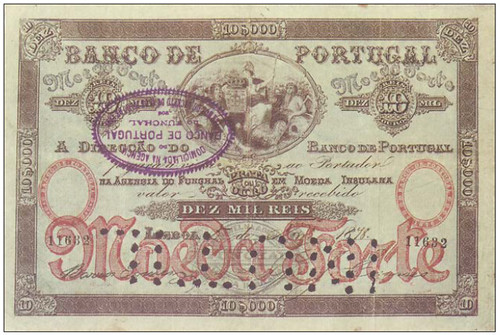
1879 Bank of Portugal Madeira provisional issue
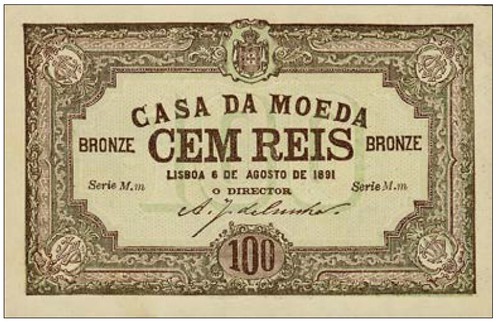
Madeira Casa da Moeda scrip note
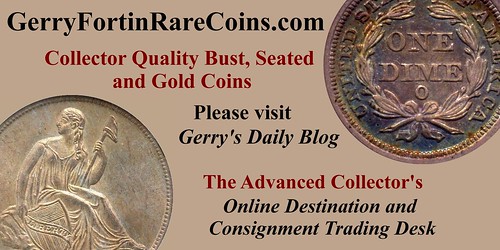
BOOK REVIEW: SAINT PATRICK COINAGE
by Syd Martin
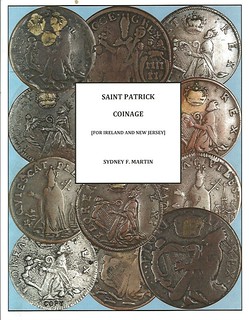 There are a few large series of coins related to – but not actually struck in – colonial North America that have long eluded the kind of systematic classification and research that all other series have long since
had. Massachusetts silver, the various state coinages, Virginia halfpennies, Fugio coppers – even series “discovered” more recently like the Machin’s Mills/Atlee halfpence – have ALL had the benefit of extensive research
and, more importantly to the collector, all have articles, monographs and books written on them that give attribution numbers and perhaps an idea of rarity.
There are a few large series of coins related to – but not actually struck in – colonial North America that have long eluded the kind of systematic classification and research that all other series have long since
had. Massachusetts silver, the various state coinages, Virginia halfpennies, Fugio coppers – even series “discovered” more recently like the Machin’s Mills/Atlee halfpence – have ALL had the benefit of extensive research
and, more importantly to the collector, all have articles, monographs and books written on them that give attribution numbers and perhaps an idea of rarity.
The four major runs of coins that are part of the colonial series that have not received this kind of detailed attention throughout the 19th and 20th centuries are the St. Patrick’s (or “Newby”) coppers, the Rosa Americana coinage, the Hibernia coppers and the French Colonies pieces struck specifically for North America. These series baffled researchers for over a century. Some tried – and made valiant attempts. The late Bob Vlack did much research on the Hibernia coinage, had access to the Norweb collection (amongst others) and prepared a manuscript that listed die varieties, though it was unfortunately never published. Vlack also researched the large St. Patrick’s pieces (popularly called halfpennies, though they bear no denomination), and published this information in The Colonial Newsletter, though the smaller size (popularly called a farthing) was never done. John Griffee was at work for something similar for the small-sized St. Patrick series when he sadly passed away. Walter Breen made an effort to get the major types of each of these series looked at in his Encyclopedia and he listed some neat varieties, but could do little more than that. For all intents and purposes collectors gave up and were content to have just a couple type coins from each of these four areas – though a brave few did try to assemble as many varieties as they could find.
The colonial world needed something of a superhero to come to its rescue, and into the fray – picture his cape waving in the wind – jumped Sydney F. Martin. Syd tackled not just one of these “undiscovered” series, but ALL of them, culminating in the recent publication of his work on the St. Patrick issues, hot off the press (published by The Colonial Coin Collectors Club, or C4, this work is available from Charles Davis at numislit@aol.com for $95 plus postage). One is amazed that a single person could do – in a VERY short period of time – what numismatists couldn’t accomplish for a century and more, but then one looks at the author’s brief biography on dust jacket. Syd received his Bachelor’s and Master’s degrees at the Massachusetts Institute of Technology, and went on to become an expert in systems analysis and worked in the defense industry. Ladies and gentlemen, we have discovered the exact kind of brain needed to make sense of these complex series, the kind that can see patterns in the chaos, link things together in ways that are easy to understand and to look closely at each and every die to find the things that make it different enough from other, similar dies, so that a logical system of attribution can be formulated and shared with collectors.
All this doesn’t mean that Syd’s books are dry recitations of attribution schemata, written in the language that one might imagine hearing the words “systems analysis.” Instead, every one of these four books give collectors everything they need to know about the coinage it covers. This begins with a thorough look at the history of the series, using all available documents and resources – and often discovering unpublished things along the way, correcting errors in our own basic understanding of some of these series. The Woods’ coinage books and the French Colonies work do this admirably, the latter even finding documents in French archives that Syd had translated and published for the first time.
The St. Patrick’s book, though, was far more difficult to write, for there is almost no evidence at all – anywhere! – about this mysterious coinage. This is simply amazing – a coinage that has nearly 200 individual die varieties, in two different sizes and three different metals (including silver and gold) has left almost no trace in the archival record, and not one peep about what they were intended to be or who made them – or when, why, where or how for that matter. We know a few things about them for certain – a large group were brought over to America in 1681 by Mark Newby to circulate in New Jersey, and that they must have been made by at least 1674 when they were first mentioned (this date further reinforced by one being found on The Royal Yacht Mary, which sank in 1675 and was recovered only in 1971). But that is pretty much all the actual evidence at hand, and the author wisely chooses to discuss some of the major theories on this coinage, both pro and con, and then puts forth a theory of his own – one that’s plausible for the What, When and How parts – the Who, Where and Why perhaps destined to remain a mystery, barring the chance discovery of some archival record: stranger things have happened, but until then, this theory will likely be considered the gold standard for the series.
The work goes on to discuss how the coins were made – the planchets, the added brass splashers, preparing the dies and the actual striking process, all based on direct examination of hundreds of examples of this coinage – sometimes the coins themselves can tell just as much as any sort of documentation, if one only figures out how to listen to what the coins are saying. The author goes into the circulation of the St. Patrick pieces in colonial North America, and then gets into the meat of the book – the actual die varieties. Syd not only gives detailed descriptions of each die, he actually groups them together in ways that suggest distinct production groups. The smaller size pieces are covered first, with the larger size ones after, the latter retaining their original Vlack designations, while the small size ones have the familiar Martin attribution system that looks complicated at first but is both logical and easy enough to master with a few tries.
Unlike the three previous titles published by C4, this one uses full color photographs for the varieties, certainly adding to the cost of production – but a good choice here since the coins literally pop off the page, and one can more clearly see the brass splashers and the tiny symbols on the King David side than if the coins had all been printed in black and white. The book itself is just over 500 pages long – with hundreds of full color photographs, and clearly the $95 price tag is a generous discount from what the book is actually worth.
For this reader, one of the more enjoyable attributes of Syd’s books are the appendices where he discusses error strikes, copies, counterstamps and other curiosities within a series – as well as more practical matters such as grading, rarity ratings, metallurgical analysis and other related areas. The current volume has some fun surprises in these areas, including what is likely a contemporary counterfeit, as well as some intriguing and deceptive modern copies.
Syd, who not only collects the colonial series in-depth, also served a long stint as the editor of The C4 Newsletter (making it one of the best club journals in all of numismatics in the process) and is currently the President of The American Numismatic Society. His quartette of books certainly raises the bar for any reference work yet to be published, and the quality of research is matched by the quality of photographs, the overall utility of the work to the collector, and the books are all well-printed and attractive. This work should, of course, be of interest to every collector of colonial coinages as well as Irish coinage, but it should also earn a place on the shelf of any bibliophile who simply appreciates a job well done.
To read the earlier E-Sylum article, see:
NEW BOOK: SAINT PATRICK COINAGE (http://www.coinbooks.org/v21/esylum_v21n21a05.html)
DIX NOONAN WEBB CATALOGS ON NEWMAN PORTAL
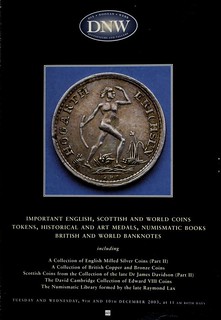 The auction catalogs of the UK firm Dix Noonan Webb, from 1991 to date, are now available on the Newman Numismatic Portal (NNP). While current catalogs are available electronically (and have been added directly),
sales in hardcopy form between 1991 and 2006 were scanned by NNP at the American Numismatic Society (ANS) library in New York. Dix Noonan Webb, a London firm, specializes in orders, decorations, medals, and militaria.
The auction catalogs of the UK firm Dix Noonan Webb, from 1991 to date, are now available on the Newman Numismatic Portal (NNP). While current catalogs are available electronically (and have been added directly),
sales in hardcopy form between 1991 and 2006 were scanned by NNP at the American Numismatic Society (ANS) library in New York. Dix Noonan Webb, a London firm, specializes in orders, decorations, medals, and militaria.
Although not focused on American numismatics, this firm often handles material of interest to American collectors, such as Betts medals and Washingtonia. A July 2006 sale featured the ever popular Libertas Americana medal (Paris Mint gold restrike, 2000), which sold for £620 ($830 at current conversion rates). Newman Portal acknowledges Peter Preston-Morley of Dix Noonan Webb, and ANS librarian David Hill for their assistance with this project.

Image: Andrew Johnson Indian Peace medal (Julian IP-40, counterstamped “E. H. Day”), Dix Noonan Webb (6/2017, lot 1781), realized £260.
Link to Dix Noonan Webb catalogs on Newman Portal:
https://nnp.wustl.edu/library/auctioncompanydetail/512703
The Commemorative Trail
To read the earlier E-Sylum article, see:
NEWMAN PORTAL: SELLING COINS BY LOTTERY : The Commemorative Trail (http://www.coinbooks.org/v21/esylum_v21n22a11.html)

KEN BRESSETT REMEMBERS WHITMAN COIN HOLOGRAMS
Dave Bowers writes:
Regarding holograms, some years ago Whitman Publishing was investigating a program of holograms for coin grading, etc., and Ken Bressett sent me a bunch of images.
Ken Bressett writes:
When Whitman first looked into the possibility it sounded like a great idea and I was all for it. I even supplied some of the coins for testing the quality and practicality. I was not working at the Whitman office and not directly involved with such projects at the time, so saw little of what was going on. Edward Metzger was in charge of product development and handled the project that took a couple of years to develop. I think the first product was ready for market in 1992, and sold for $27.50.
I remember seeing early attempts at producing sheets of holograms for Morgan and Peace dollars. I think that $20 gold coins were also in the works, but don’t know if production sheets were ever finished. These were mounted on cards with images and descriptions of each denomination in six grades from MS-65 to EF-45. The actual work was done by Polaroid’s hologram division in Massachusetts.
Apparently the experiment was not successful. The images were a deep green color which made the coins look unnatural. Under magnification the coins were clear and well defined, but the cards were awkward and hard to use for comparison with a coin to be graded. As far as I know production was aborted shortly after the initial release.
To read the earlier E-Sylum article, see:
NUMISMATIC LASER GRAPHICS COIN HOLOGRAMS (http://www.coinbooks.org/v21/esylum_v21n22a15.html)
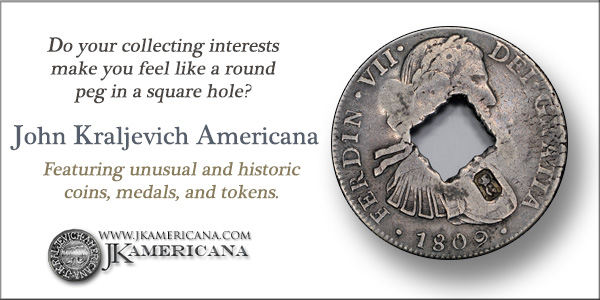
SILVERTOWNE SLABS
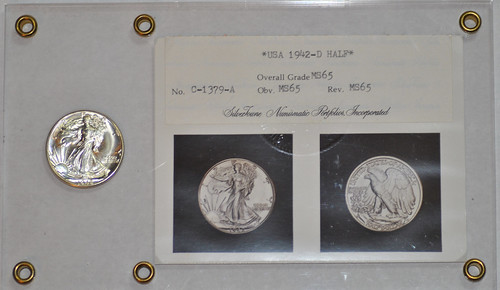
Bruce Smith writes:
The E-Sylum hologram piece put me in mind of this slab that I'm guessing is from the late 80s - early 90s. It's 4 1/2" x 7 1/2" and about a quarter inch thick fastened with six brass rivets. These appear to have been both created and sold by SilverTowne in Winchester, IN. The reverse of the photo grade sheet describes the guarantee and buy back conditions.
I acquired this only recently, and I'm not sure why, as I don't collect either Walkers or slab types. It must have been the "I've never seen one of those before," factor. Perhaps some readers will have more information to share.
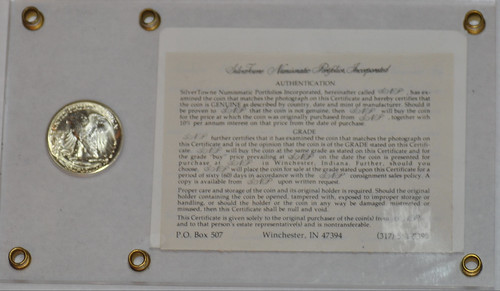
To read the earlier E-Sylum article, see:
NUMISMATIC LASER GRAPHICS COIN HOLOGRAMS (http://www.coinbooks.org/v21/esylum_v21n22a15.html)

NOTES FROM E-SYLUM READERS: JUNE 10, 2018
Bishopric Sede Vacante Coins
Axel Kornfuehrer of Hopkins, MN writes:
While I am not an expert on the usages of "Sede Vacante", I can tell you that "the seat is vacant" refers to any period of time when a bishopric (or higher, like the Vatican) is between bishops. The previous bishop has died; a new one has not yet been chosen. I collect coins of the bishopric of Eichstätt (in central Bavaria, in the Altmühl valley; existed as a political entity 742 to 1806; still a bishopric today). Eichstätt minted at least three "Sede Vacante" coins -- a 1757 Taler, a 1781 Taler, and a 1790 Doppeltaler. I have not researched how many other German bishoprics, if any, minted "Sede Vacante" coins.

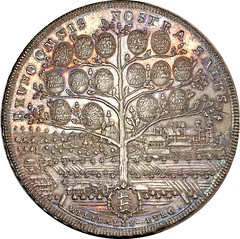
1790 Eichstätt Doppeltaler
Axel adds:
As a child, I lived in Eichstätt from December 1948 to May 1952. That view of the "Willibaldsburg" (the castle shown on the coin) is roughly the one I had out of the window of my room. Note the names on the leaves of that coin. I tripped across the online fascimile copy of an 1845 catalog of Eichstätt coins that lists those names as part of a lengthy description of the images on this coin.
I was pleasantly surprised to find information on other German bishoprics that minted "sede vacante" coins in the 16th, 17th and 18th centuries. In going through the photos found on Google, there is one that shows a postcard with a cathedral and some coin images. It notes a Zepernick classification system (never heard of it before).
To read the earlier E-Sylum article, see:
NEWMAN PORTAL SEARCH: 1719 SEDE VACANTE (http://www.coinbooks.org/v21/esylum_v21n22a12.html)
Which JEAN Do You Mean?
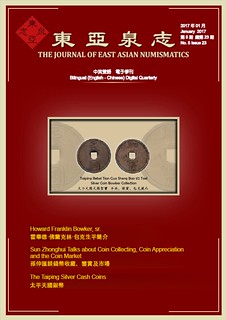
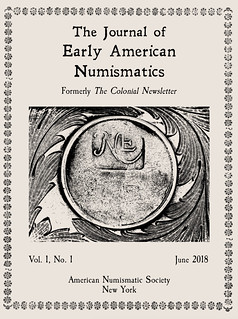
Regarding the new Journal of Early American Numismatics (JEAN), Dennis Forgue writes:
This change from the ANS Colonial Newsletter might get confusing in that the Journal of East Asian Numismatics also uses JEAN and just published their 10th issue.
To read the earlier E-Sylum articles, see:
JOURNAL OF EARLY AMERICAN NUMISMATICS LAUNCHED (http://www.coinbooks.org/v21/esylum_v21n22a10.html)
JOURNAL OF EAST ASIAN NUMISMATICS JANUARY 2017 (http://www.coinbooks.org/v20/esylum_v20n08a05.html)
Coin-Operated Piano Token Issuers Identified
Regarding his request for information on issuers of tokens used in coin-operated pianos, Dave Bowers writes:
I’ve had about a half dozen solutions/answers from E-Sylum readers. Very impressive!
To read the earlier E-Sylum article, see:
ASSISTANCE SOUGHT IN IDENTIFYING TOKEN ISSUERS (http://www.coinbooks.org/v21/esylum_v21n22a27.html)
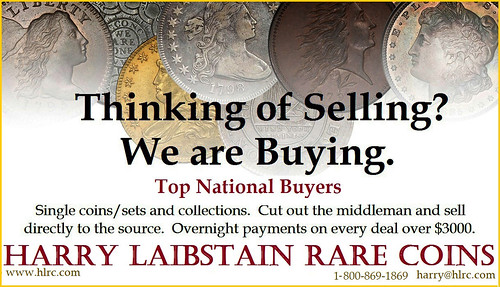
HOW TO MAKE A KILLING IN COINS
I knew there had to be a better way to get rich than working for a living, and I believe I've found it. This valuable pamphlet has all the answers! From the daisy wheel printing, my guess is that this dates from the 1980s.
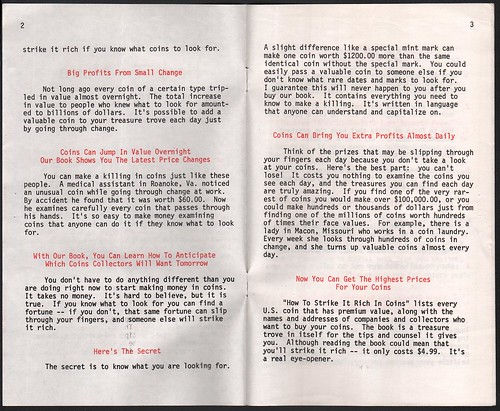
Joel Orosz writes:
I probably have the most comprehensive collection of U.S. coin investment literature from the beginning of this particular plague around the start of the 20th century until the great crash of 1965.
Prior to 1965, with prices mostly on an upward plane, the investment literature was usually naive and optimistic; after that date, dealers realized prices were not immune to the laws of gravity, so investment literature became more and more bloviating and cynical. And accordingly, I have collected nothing of the genre post-1965.
This attached piece is actually one of the more restrained examples of the post-1965 genre of numismatic investment literature that I have read. I did chuckle at the repeated references to the weight of the book—numis lit by pound—but at least the author didn’t promise endless riches without the need to do any studying.
So, while I could write a dissertation about earlier authors like Bilinski or Haylings and their work, I know nothing of this fellow and his contribution the—ahem—“literature” of post-1965 hypesters.
Welcome to FC&A Publishing! For over 45 years, our company has had the privilege of helping people across the nation.
As a leader in the marketing and publishing industry since 1969, we specialize in nonfiction, self-help publications. We love to discover the latest and greatest information in a variety of categories such as healthy living, household and gardening, money-saving, computer know-how, and so much more!
We have sold over 28 million copies of our bestselling books, over 4 million jars of our clinically-proven Pain Relief Rub, and over 1 million jars of our popular Age-Away Skin Cream — and we’re just getting started!
Our mission is to improve the lives of every person we touch, one book at a time!
I contacted the company via their web site to ask if they indeed published the How to Make a Killing in Coins booklet. If the copyright is theirs we would need their permission to place it on the Newman Numismatic Portal. But if the publisher cannot be found and the copyright is believed to be orphaned, that would also allow us to post it. Great literature it's not, but it is a part of numismatic history, and all of that is worth making available to future hobbyists and researchers. Thanks, Dave. -Editor

VOCABULARY TERMS: UNIFACE AND SINGLE-SIDED
Uniface. A single-sided medallic item; a numismatic item with a blank reverse; detail and design appearing on one side only. A struck piece particularly is called uniface; a cast piece is more apt to be called SINGLE-SIDED. Many medallic items – plaques, paperweights and badges – are almost always uniface; medallions and seals are frequently so, but the term can rightfully be applied to any medallic or numismatic item with design on one side only – the obverse. In describing such items the reverse of a uniface item is called BLANK REVERSE, FLAT BACK or PLAIN REVERSE.
Many uniface items have mounting or supporting features on the back, as paperweights often have BALL FEET on the back to support them on a desk; plaques have hangers on the back for hanging on a wall; and badges have fasteners on the back for attaching to garments. Some die-struck medallic items may have a border or rim on the back (struck from a blank die with such a border or rim). Also many uniface items have a MAKER’S MARK, a FOUNDRY MARK or HALLMARK on the back side. All these features do not detract from the status of the item from being uniface. The design is on the principal side –the obverse – the reverse is devoid of design.
Some medallic items will never be uniface. An example might be a medal with a swivel loop (there would be no need to turn over such a medal to observe the reverse only to find nothing there). Most art medals or any quality medal will obviously have two sides, to exploit the medallic medium to its fullest, these would never be uniface.
The only need for a medallic item to be uniface is where in the normal course of its use or display it would exhibit one side only, the back would always be obscured from view, as one framed or intended to be hung on a wall.
It should be noted uniface medals should never be confused with CLICHÉS (two thin blanks struck at the same time to form separate obverse and reverse pieces); these are uniface but the interface sides will exhibit suction
marks which should correctly identify these as clichés. Finally, in proving dies, led proofs are always uniface when dies are proved one die at a time.
CLASS 11.4
Single-sided. A uniface cast medallic item. The backside or reverse of a single-sided item may be smooth, rough, have depressed areas congruent with the high relief of the obverse (called CAST HOLLOW), or have a surface of ripples and rounded edges typical of an open mold casting. The back side may also have a BACKPLATE. The reverse often has a MAKER’S MARK, a FOUNDRY MARK or HALLMARKING, or, the item can have a hanger for wall mounting. The term is applied only to cast pieces as a one-sided struck piece is called UNIFACE.
Cast medallic items with both obverse and reverse designs are said to be DOUBLE-SIDED. In cataloging, if the piece is identified as a cast and only one side is described, it is not necessary to specify the item is
single-sided (that is obvious). Otherwise if no description is given the piece is called single-sided.
CLASS 07.2
Looking for the meaning of a numismatic word, or the description of a term? Try the Newman Numismatic Portal's Numismatic Dictionary at: https://nnp.wustl.edu/library/dictionary
Or if you would like a printed copy of the complete Encyclopedia, it is available. There are 1,854 terms, on 678 pages, in The Encyclopedia of Coin and Medal Technology. Even running two a week would require more than 19 years to publish them all. If you would like an advance draft of this vital reference work it may be obtained from the author for your check of $50 sent postpaid. Dick Johnson, 139 Thompson Drive, Torrington, CT 06790.
GILBERT WILLIAM GILL (1838-1910)
This week's subject is G. W. Gill, one of the earliest known coin collectors in Memphis, TN. His fictional essay "What is the Use of Coin Collecting" appeared in the September 1883 issue of Numisma. -Editor
Gilbert William Gill (1838-1910), was born on May 22, 1838, in Marylebone, Middlesex, England, son of Richard (1804-), and Elizabeth Chasey Gill (1803-).
In 1861 he lived with his parents at Lewisham, Kent, England.
He is listed among the passengers as 31 years old, a carpenter by trade, aboard the ship Hudson that arrived in New York on July 29, 1869.
Gill moved to Memphis,Tennessee.
Besides his trade as a carpenter Gill was also a very lucid writer and used to write pieces for the newspapers.
Keep in mind Gill was a native Englishman and born into a country where slavery had been abolished before he was born. Moving into Memphis, Tennessee, not long after the Civil War the culture was still much the same as before the War and it did not sit squarely with Gill.
Gill wrote a criticism of the politics at Memphis in the local newspaper that caused a large stir for weeks. Knowing it would create a stir he asked a friend Theodore Krekel to submit his essay to the Avalanche for publication. On July 11, 1880, it was published in the Sunday edition signed anonymously as "Southern Democrat" which caused outrage, indignation and an investigation into the author's identity.
Gill is among the earliest known coin collectors of record in Memphis, Tennessee.
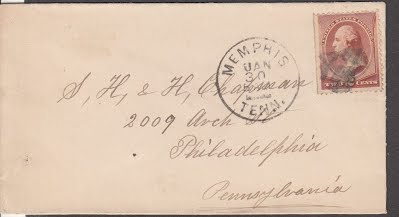
Gill correspondence with the Chapman Brothers postmarked January 30, 1886, 5 AM, Memphis, Tennessee. Gill purchased Pattern Pieces from the Chapman Brothers who acquired them directly from the U. S. Mint at Philadelphia.
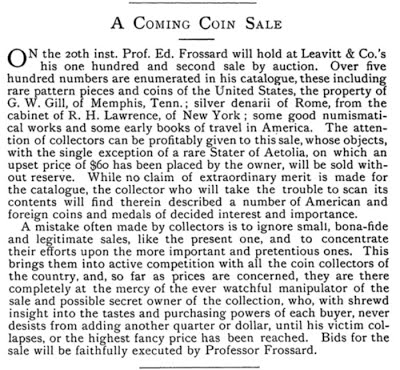
To read the complete article, see:
GILL, GILBERT WILLIAM (https://sites.google.com/a/numismaticmall.com/www/numismaticmall-com/gill-g-w)
The entire inventory of the Lupia Numismatic Library is for sale. Individual items will be available before the remaining archives are broken up into parcels sold at philatelic auctions in the U. S. and Hong Kong. Check NumismaticMall.com frequently as dozens of new items with estimates will be posted daily until everything is sold.
All inquiries will be given prompt and courteous attention. Write to: john@numismaticmall.com .
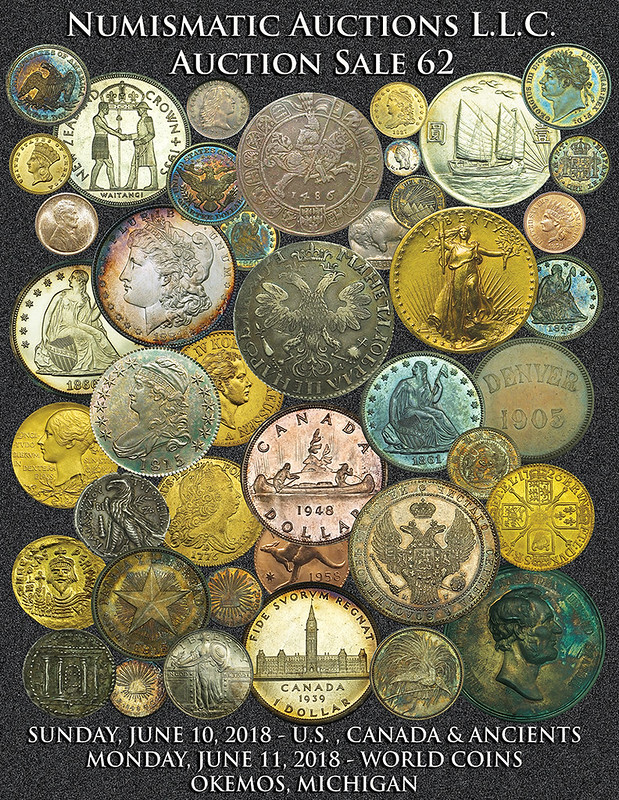
SELECTIONS FROM THE FRANK ROBINSON JULY 2018 SALE
Lot 30: EGYPT, PHARAOH NEKTANEBO II
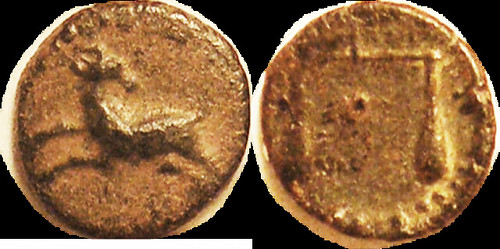
EGYPT, PHARAOH NEKTANEBO II, 361-343 BC, Æ13, Leaping ram/scales, VF, obv centered, rev just sl off-ctr, dark green patina with earthen hilighting. The ONLY coin of Egypt of the Pharaohs (there's also a very rare gold version), though some evidence suggests a Syrian issue. (A GVF brought $4313, Triton 1/05; VF $5423, Gorny 3/07).
To read the complete lot description, see:
EGYPT, PHARAOH NEKTANEBO II, 361-343 BC, Æ13 (https://emax.bid/en/lot/170776)
Lot 188: MARK ANTONY & OCTAVIAN
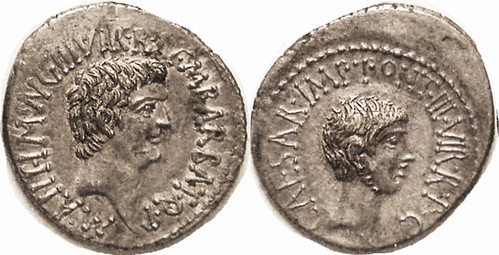
MARK ANTONY & OCTAVIAN, Den, Head r/head r, Cr.517/2; EF, egg-shaped flan, sl obv flatness at upper left edge & rev somewhat off-ctr, but lgnds complete; decent metal with medium grey tone. Insignificant striking imperfection on Tony's chin, still excellent portraits with sharp hair detail. (A Near EF brought $6900, CNG 5/11; GVF $2142, NAC 5/13.)
To read the complete lot description, see:
MARK ANTONY & OCTAVIAN, Den, Head r/head r (https://emax.bid/en/lot/170931)
Lot 331: GALLIENUS, Egypt Tetradrachm, Eagle
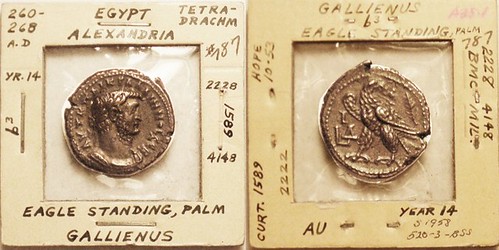
GALLIENUS, Egypt Tet, Eagle l., hd r, palm, Yr 14; Nice AEF, centered, sl ragged flan, well struck, good medium brown patina. Ex Curtis with his distinctive carefully lettered holder. (A VF, this exact var., brought $240, Peus 4/13.)
Frank Robinson adds:
"Curtis" is James W. Curtis, who wrote the book on Egyptian tetradrachms.
To read the complete lot description, see:
GALLIENUS, Egypt Tet, Eagle (https://emax.bid/en/lot/171074)
Lot 418: PHOCAS, Gold Solidus

PHOCAS, Gold Solidus, S620, Facg bust/Angel stg, Offic.H; Lustrous EF+, perfectly centered, well struck with sharp portrait, a few sm scrs at rev top (A GVF brought $604, CNG 5/12)
To read the complete lot description, see:
PHOCAS, Gold Solidus, S620, Facg bust/Angel stg (https://emax.bid/en/lot/171161)
Lot 488: "THE KING OF SIAM PROOF SET"
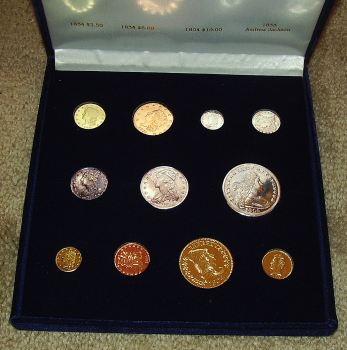
The LEGENDARY "King of Siam" Proof Set of 1834, the most famous & desirable item in all numismatics. Eleven pcs incl 1804 $1 & $10, and Andy Jackson medalet, in plush case. Well, OK, they are marked "COPY" but still a pretty cool item. (Gold are not real gold; silver appear silver with some nice toning.)
To read the complete lot description, see:
The LEGENDARY "King of Siam" Proof Set of 1834 (https://emax.bid/en/lot/171231)
To access the complete auction, see:
http://emax.bid/en/auction/228

SELECTIONS FROM THE JUNE 2018 EARLY AMERICAN SALE
George Washington Signed Mountain Road Lottery Ticket

1768-Dated Colonial Era, Partially-Printed Document Signed, “G(eorge) Washington” on a “Mountain Road Lottery” Ticket, Choice Extremely Fine. This excessively rare example of a Mountain Road Lottery Ticket, measuring about 1.5” tall x 4.5” long with the signature of the Father of our Country as signer and proprietor. This Colonial Virginia Lottery Ticket states that the possessor shall be entitled, “to whatever PRIZE may happen to be drawn against its Number in the Mountain Road Lottery.” This Ticket is well centered, slightly trimmed at the top printed divider line, as are virtually all known examples and tipped heavier paper along the outer edge for protection and support to display. The quality of George Washington’s signature is sharp and clear, carefully written in medium tan ink and it measures a full 1.75” across. The overall visual appearance is fresh and very clean, the “G. Washington” signature is excellent and clear. Ticket No. 348. This original, historic piece of Washingtonia is a Key item and is considered the “King” of American Lottery Tickets. A wonderful, prize in the collecting of Colonial era American lottery tickets and George Washington autographs.
The Mountain Road Lottery was described by the Virginia Gazette as "A Scheme of a Lottery for raising the sum of nine hundred pounds, to make a road over the mountain to the warm and hot springs in Augusta county." The Mountain Road Lottery offered 62 cash awards, including a 1,000 pound first prize. Tickets were sold for 20 shillings, with "15 percent to be deducted from the Prizes."
On February 21, 1771, Captain Bullitt placed a notice in the Virginia Gazette that notified Washington and others that the "Hot Springs, Augusta County" project agreement between them was rescinded. The road was never built with this lottery endeavor. However, the Mountain Road was built in 1772 when the Virginia legislature voted a sum of 300 pounds for the purpose of "clearing a safe and good road from the Warm Springs in Augusta County to Jennings Gap." That road is now part of Virginia Routes 629 and 39 from Jennings Gap into Warm Springs Valley, site of the famous Homestead Hotel. Bullett went on alone and later built the road and spa in Hot Springs.
To read the complete lot description, see:
George Washington Signed Mountain Road Lottery Ticket 1768 Virginia - The “King” of American Lottery Tickets
(https://www.earlyamerican.com/Auctions/ClientPages/lots.item.php?auction=6&lot=61)
Washington Pater Patriae Inaugural Button
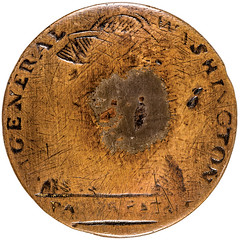

(1789) George Washington Inaugural Button, “GENERAL WASHINGTON - PATER PATRIAE” Major Design Type with General Washington in Uniform. 25 mm. Copper shell with lead-filled base as made. With Original Shank. Albert WI-19B. DeWitt GW-1789-41. Fine.
Rarity-6 (3 to 5 known) according to Albert, (currently believed 6 to 7 known). 25 mm. This extremely rare “GENERAL WASHINGTON - PATER PATRIAE” type features a central Bust Portrait of General George Washington dressed in his fancy military uniform. Above at its left and right sides reads, “GENERAL - WASHINGTON” and below the bust, “PATER PATRIAE”. This historic button has a Copper shell with lead-filled back, as made with its original iron shank intact. This example is well worn at its center, though the outer inscription “GENERAL WASHINGTON” is clear, plus portions of the well worn lower inscription can be read, with still parts of the Washington design seen.
Another example of this GW Inaugural Button Type in nicer but not choice condition, sold in the Stack’s Cobb Collection sale of January 21, 2003 for $22,000 (hammer price, totaling $25,300), plus a low quality example in 2015. In February 2018 another example was offered at auction from the David & Janice Frent Collection which did not provided a specific grade yet stated to have been “well-struck with strong detail” which this cataloger would have graded as Extremely Fine. That example, being one of the finest known for the type sold for the remarkable world record price of $225,000.
To read the complete lot description, see:
“General Washington - Pater Patriae” Inaugural Button Ultra-Rare Key Design Type Considered “The Holy Grail”
(https://www.earlyamerican.com/Auctions/ClientPages/lots.item.php?auction=6&lot=140)
Uncle Sam's Change Postage Stamp Envelope
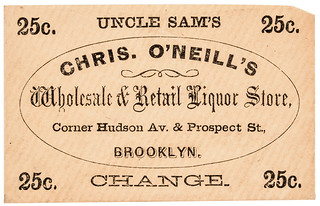
Chris. O’Neill’s Wholesale & Retail Liquor Store, 25 Cents U.S. Postage Stamp Envelope, Black printed text on Buff wove envelope,
Rarity-9 (1 to 3 known) according to Fred Reed. of this Civil War period U.S. Postage Stamp Envelope thought to exist. #KL103-25. Deep well centered Black printed text on buff envelope, “25c,” printed in all four corners. Printed text reads: “UNCLE SAM’S/ CHANGE.” (printed at top & bottom), with “CHRIS. O’NEILL’S / Wholesale & Retail Liquor Store, / Corner Hudson Av. & Prospect St., / BROOKLYN.” (printed within a fine black oval at center). Highly attractive and distinctive in its design and overall appearance being Complete but for its flap. One of only two Varieties known. Likely Unique and the Finest Known prize for the successful bidder having been used for the Plate Illustration Example In Friedberg.
To read the complete lot description, see:
Rarity-9 Plate Illustration Example In Friedberg “UNCLE SAM’S / CHANGE. - CHRIS. O’NEILL’S / Wholesale & Retail Liquor Store,/
Corner Hudson Av. & Prospect St. / BROOKLYN.” Exceedingly Rare New York Merchant Type (https://www.earlyamerican.com/Auctions/ClientPages/lots.item.php?auction=6&lot=201)
1869 Fisk Mills Postal Currency Envelope
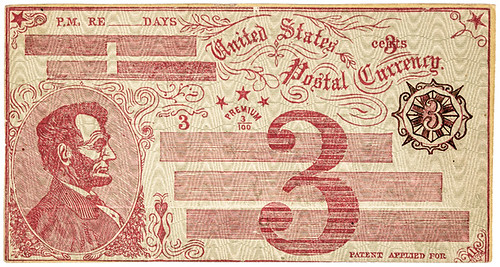
1869 Fisk Mills of Washington, D.C.. Three Cents. Abraham Lincoln Vignette Design. Unadopted Envelope Essay for “United States Postal Currency.” Undersander Number E804d. Extremely Fine.
This Unique Design Type Essay has ornately Engraved designs which are printed in rich red on a light green and white “wood grained” background. This is the front panel, mounted onto thin boxwood card for display, measuring 3” tall x slightly more than 5.5” wide. In the upper right field, below the word “Currency” is a unique hand-drawn additional design element, showing a “3” centered within several brownish-red ornate designs. At the bottom right are the words, “PATENT APPLIED FOR” with a small patriotic Union shield design in the corner. At top left, “P.M. RE______DAYS.” At the upper right is printed the stated use, “United States Postal Currency.” Unique in this format. Undersander Number E804d. Attributed as being Ex: Brazer Collection. This is a handsome, impressive looking, highly colorful Postal Currency and Philatelic related item of museum quality that has great eye appeal for display.
To read the complete lot description, see:
Unique “United States Postal Currency” 1869 Fisk Mills 3¢ Abraham Lincoln Vignette Design Envelope “Essay” Type
(/www.earlyamerican.com/Auctions/ClientPages/lots.item.php?auction=6&lot=207)
Charles Geekie Tokens & scrip
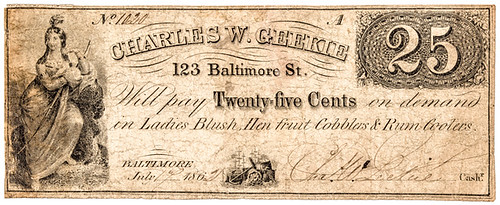
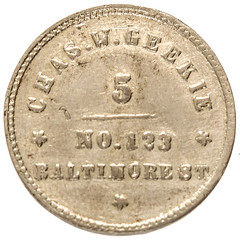
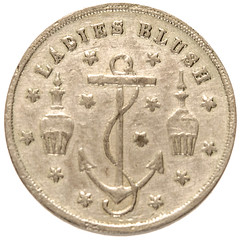
Circa 1860 Exceptional Collector Archive Lot of Five CHARLES W. GEEKIE "Ladies Blush" Items. Set of (4) Tokens; (2) Struck in German Silver & (2) Struck in White Metal and (1) 1862 Hand-dated Civil War Period Currency Note.
Circa 1860 Geekie Baltimore, Maryland Trade Tokens. (2) German Silver and (2) White Metal, 23 mm, about 3.6 gm. The trade tokens of Charles W. Geekie are rarely offered for sale and are extremely underrated. This is the first example ever to be offered at the auction block at Early American History Auctions, and to have a Set of FOUR is simply extraordinary! The “Anchor” and two “Decanters” on the obverse are motifs with ties to Geekie's liquor business at 123 Baltimore Street in Baltimore, Maryland. These example are as nice as known for the issue, two being a solid AU tokens with lustre. The surfaces appear to be typical for what is known and under magnification trivial imprefections observed within the devices or as described individually and im aged below. Rulau's 2004 reference values this rare issue at $500 in VF, with no prices provided beyond that grade. We located one auction record from 2008 for a German Silver “5” example graded AU which sold for $690 (it was also the very first example that major firm had ever offered). The same type offered in the current set being finer and more lustrous. A wonderful opportunity to acquire a remarkable set of four, together with a Signed “Geekie” Note!
To read the complete lot description, see:
Rare Charles Geekie "Ladies Blush" Trade Tokens Archive
(https://www.earlyamerican.com/Auctions/ClientPages/lots.item.php?auction=6&lot=328)

SEARS MARYLAND LOTTERIES RESEARCH COLLECTION
Early American History Auctions is offering as a single lot in their June 23, 2018 sale the entire research collection behind their 2016 book on pre-Civil War Maryland lotteries. Here's the lot description and a few photos. What a great opportunity! -Editor
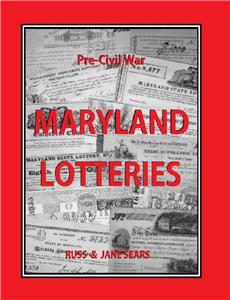 Comprehensive Historical Research Collection of Russ & Jane Sears of more than 30 years containing about 242 Items of highly focused dedicated effort to compile this important Archive many items of which were
used for production and illustration of their 190 page profusely Illustrated Reference Book titled, “Pre-Civil War MARYLAND LOTTERIES”.
Comprehensive Historical Research Collection of Russ & Jane Sears of more than 30 years containing about 242 Items of highly focused dedicated effort to compile this important Archive many items of which were
used for production and illustration of their 190 page profusely Illustrated Reference Book titled, “Pre-Civil War MARYLAND LOTTERIES”.
Though new discoveries for other Lotteries on Maryland possibly exist, we are certain that no other current collection exists having the tremendous organized depth of major types, sub-varieties, advertising, and related historical material for Maryland Lotteries than contained here in massive Russ & Jane Sears collection. This is the foundational collection of material contributing to, and many additionally illustrated within, the 190 page book titled: “Pre-Civil War MARYLAND LOTTERIES.” Sadly, longtime avid collector and author Russ Sears passed on May 18th, 2016. As a tribute to the work accomplished, the core material used to comprise that book if offered here intact. Please view the entire comprehensive listing of related documents, memorabilia, advertising pieces and broadsides of this lot. Also, please view online images of all 242 items, including a copy of Russ & Jane Sears reference book, “Pre-Civil War MARYLAND LOTTERIES.” (approx. 242 items).
Well known to Collectors from across America, and naturally in his home city of Baltimore, Russ was sometimes a guest speaker for his Baltimore Coin Club. He was always a “regular” attendee of the local Coin and Currency shows. When another Maryland collector consigned his collection years ago to auction, then considered the finest known, Russ and Jane embraced that opportunity to greatly expand and enhance the depth of their own collection. Those acquisitions projected their collection, now offered here, to be ranked as the finest, most complete on Maryland Lotteries currently known to exist!
In tribute to their decades of collecting efforts to compile this rare material, it is offered intact, together with a printed copy of their 190 page illustrated reference book “Pre-Civil War MARYLAND LOTTERIES”. We encourage every interested collector to order a copy for their own research library: ISBN - 13:978-1537540085. Russ noted that the book’s title came into being as various state laws were enacted by the legislature declaring public lotteries to be illegal in Maryland in 1859, just prior to the start of the Civil War. The acquisition of this highly important, valuable historical primary reference archive collection can not be achieved as it represents a lifetimes passion. Whether a private collector, representative of an institution or library, this offering is a truly presents a remarkable opportunity! Ex: Russ & Jane Sears Baltimore, Maryland Collection.
RUSS SEARS’ LAST THOUGHTS:
For almost forty years we have collected historical artifacts. Shortly after beginning what seems like a career of collecting, we decided that each artifact had a story. It was fun collecting and it was more fun learning
about how the artifact was used, what was going on in history when it was used, who actually touched the artifact and any other information we could find. Our primary interest has been in Baltimore history. As time went on,
we expanded the type of artifacts we collected and sometimes acquired more than one type of artifact from the same business or person. Although we began as token collectors, we soon moved into medals. Bill heads and letter
heads were used by many businesses and sometimes matched those who used tokens. There was research to be done, but it took time and energy to do it. We seemed to be continually adding new items to our collections and our
interest in Baltimore history expanded more and more.
Over the years we accumulated real treasures from history as we collected and research. In some cases we had already learned about a merchant or an industry and worked on adding artifacts from them to our collections. There is something special about an item which was owned or signed by Johns Hopkins, William Welch, Daniel Gilman, John Goucher, Henry Walters, Charles Carroll of Carrollton, Frederick Douglass, Enoch Pratt, A. S. Abell and others whose names may not strike your memory like Lyttleton Frye Morgan (Morgan State University), George P. Kane (Police Marshal on April 19, 1861, later Mayor), George William Brown (Mayor on April 19, 1861), John L. Chapman (Mayor for most of the Civil War), Augustus Bradford (Baltimorean and Maryland Governor for most of the Civil War) and many more people who made history.
Since we have been interested in just about all phases of 1800's Baltimore history, we sometimes say that if your ancestor was in Baltimore in the 1800's, we have something from them, their neighborhood or the industry in which they worked. Several years ago, Frank J. Murphy mentioned that his family had a department store on Baltimore Street. That sounded familiar and when we went home, we pulled about a dozen 1880's items from his family's store out of our collection to show him.
Over the years we have presented historical talks to over fifteen local and national/international organizations. Items from our collections have been exhibited at Fort McHenry National Monument and Historic Shrine, The Carroll Museums, Clifton Mansion, Baltimore County libraries and The Fire Museum of Maryland. Our research and articles have won numerous awards, primarily from the Maryland Token and Medal Society. We enjoy history, collecting and sharing.
Over the last several years, we have written and published books on Pre-Civil War Baltimore Lotteries, Baltimore Packing & Canning Industry, Lucky Bucks & Other Comic Play Money from Depression Era Newspaper 1932-43 and Pre-Civil War Maryland Lotteries.
This Cataloguer’s note... There has been no such comprehensive and organized listing of specialized Baltimore, Maryland Lotteries are related materials, or regarding early American Lotteries in general, since dealer Paul C. Richards prepared his extensive price listing of 284 different major issuers and varieties titled, “ONE HUNDRED YEARS OF AMERICAN LOTTERY TICKETS - 1744 to 1844 - A CATALOGUE” which was produced in the 1970s. The collector passion of Russ Sears is well presented, together with his wife Jane, in his 190 page illustrated reference book titled “Pre-Civil War MARYLAND LOTTERIES”. Though difficult to estimate given its size and scope, it was thought best to keep this core collection of 30 years intact, being such a monumental achievement. It is literally irreplaceable, and likely could never be reconstructed again. Please view this comprehensive lot listing and all images Online at: www.EarlyAmerican.com. (242 items).
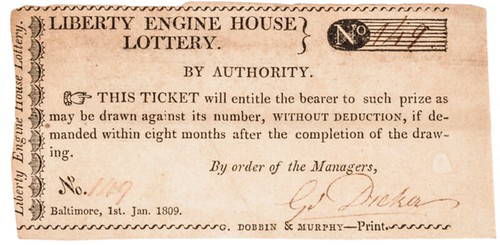
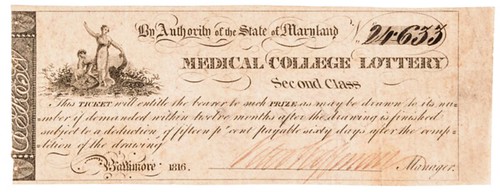


To read the complete lot description, see:
Russ & Jane Sears Historic Research Reference Collection For “Pre-Civil War MARYLAND LOTTERIES” 242 Items
(https://www.earlyamerican.com/Auctions/ClientPages/lots.item.php?auction=6&lot=178)
To read the earlier E-Sylum articles, see:
NEW BOOK: PRE-CIVIL WAR MARYLAND LOTTERIES (http://www.coinbooks.org/esylum_v19n43a07.html)
RUSS SEARS (1942-2017) (http://www.coinbooks.org/v20/esylum_v20n21a08.html)
MORE ON RUSS SEARS (http://www.coinbooks.org/v20/esylum_v20n22a21.html)

SINGAPORE TRUMP-KIM SUMMIT COMMEMORATIVE COINS
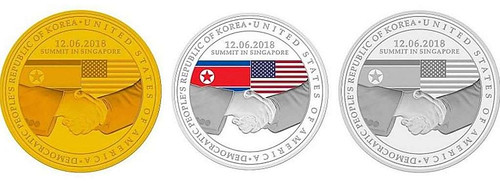
The three gold, silver, and base-metal medallions commemorate the summit as a "momentous step to world peace" and show Singapore's role as a "neutral host, and an economic and security gateway between the East and the West," according to a news release from the mint.
"The obverse design of the medallion features an affirmative handshake between the two leaders, minted with high-relief minting technique, and the national flags of both countries," according to a description from the mint. "North Korea’s national flag is depicted on the left, while the United States’ national flag is depicted on the right, aptly representing both countries’ position on the political spectrum."
Each medallion features the inscription "World Peace" on the back, in addition to a dove and olive branch motif. The national flowers of the United States and North Korea, rose and magnolia sieboldii, are also located on the rear of the coin.
Singapore's commemorative coins, of which only a few thousand pieces have been made, were available to pre-order from the mint on Tuesday and cost more than $1,300 for the gold version, $118 for the silver, and $36 for the base-metal version.
To read the complete article, see:
Singapore unveils commemorative coins for Trump, Kim summit
(https://www.msn.com/en-us/news/world/singapore-unveils-commemorative-coins-for-trump-kim-summit/ar-AAyfIGp)

TEC CREATES ERIC P. NEWMAN ELONGATED COINS
 The Eric P. Newman Numismatic Education Society (EPNNES) recently awarded a donation of $5000 to The Elongated Collectors (TEC). In thanks, TEC created an elongated coin depicting EPNNES founder Eric P. Newman, and
will donate a quantity of these coins to that organization.
The Eric P. Newman Numismatic Education Society (EPNNES) recently awarded a donation of $5000 to The Elongated Collectors (TEC). In thanks, TEC created an elongated coin depicting EPNNES founder Eric P. Newman, and
will donate a quantity of these coins to that organization.
TEC is also creating a set of four elongated coins with this design on a cent, 5-cent, dime and quarter. These sets will be available at the American Numismatic Association World’s Fair of Money (WFoM) in Philadelphia, and at the TEC store. Pre-orders are being taken now but delivery will be at or after the WFoM. If you are planning to attend, save on shipping by using the code ILLBETHERE18. This code is good only for pre-orders picked up at the show, all other TEC shop items must be by separate order with shipping.
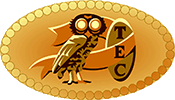 TEC is an organization dedicated to the elongated coin. Check us out at our website http://tecnews.org/ or on Facebook ( https://www.facebook.com/groups/491018311250248/). All visitors are invited to join the club while learning about the funnest part of numismatics.
TEC is an organization dedicated to the elongated coin. Check us out at our website http://tecnews.org/ or on Facebook ( https://www.facebook.com/groups/491018311250248/). All visitors are invited to join the club while learning about the funnest part of numismatics.
To order, see:
https://tecnews.org/Store/index.php?main_page=index&cPath=16
THE BOOK BAZARRE
WELLINGTON PIT DISASTER EDWARD MEDAL
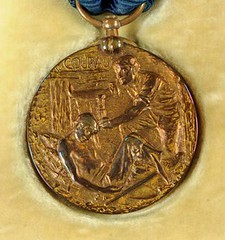 A bravery medal from Whitehaven's Wellington Pit disaster and a 1830s Maryport shipbuilder's ledger will be among the items going under the hammer at a Cockermouth sale next week.
A bravery medal from Whitehaven's Wellington Pit disaster and a 1830s Maryport shipbuilder's ledger will be among the items going under the hammer at a Cockermouth sale next week.
The Edward Medal, which in the mining world's equivalent to the Victoria Cross, was awarded to John Thomas Mather for courage shown in the attempted rescue of miners trapped by fire in the Wellington Pit disaster in Whitehaven on May 11, 1910.
 Sixty four men were awarded bronze Edward medals after the disaster - the greatest number ever given for one incident, which underlines the scale of the tragedy in which 136 men and boys died.
Sixty four men were awarded bronze Edward medals after the disaster - the greatest number ever given for one incident, which underlines the scale of the tragedy in which 136 men and boys died.
The medal comes with its original presentation case from the direct descendants of Mr Mather. It is expected to sell for between £1,200 to £1,500.
To read the complete article, see:
Whitehaven pit disaster medal to go under the hammer in Cockermouth
(http://www.newsandstar.co.uk/news/Whitehaven-pit-disaster-medal-to-go-under-the-hammer-in-Cockermouth-5a5346fd-2756-4b7d-a25e-df726510fabf-ds)
THE YUKON MINT KASKA GOLD COIN
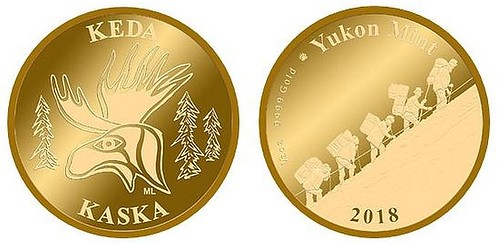
Chief owner and chairman of McEwen Mining, Rob McEwen, has purchased the first one-ounce gold coin minted by project developer Golden Predator Mining’s (TSXV: GPY) subsidiary, Yukon Mint.
McEwen is one of GPY's largest shareholders and the purchase reflected the first gold coin produced in the Territory.
The .9999 purity 2018 Kaska ‘Keda' (Dene for ‘Moose') gold coin depicts the winning artwork of Kaska Nation artist Miranda Lane, on both a series of 180 one-ounce and 140 half-ounce coins, which will be available for sale in limited edition, starting on Canada's National Aboriginal Day, to be observed on June 21.
A percentage of the net profits from the sale of the coins will be shared with the Kaska Nation.
Golden Predator says the Yukon Mint gold coins will be part of a limited yearly series of First Nation art on the obverse side of the coin, selected through design contests, and combined with the iconic image of Klondike Gold Rush stampeders on the reverse. Each coin has been engraved with a security feature to ensure its authenticity.
Golden Predator says gold produced from its flagship 3 Aces project bulk sample of 2016 is incorporated into the coins. The bulk sample material comprising 776 metric tonnes of ore was processed at the company's test facility using water and gravity only, without the use of chemicals, and produced 953.4oz of gold, with 199oz of gold remaining in the tails.
To read the complete article, see:
First Yukon Mint coins contain 3 Aces bulk sample gold
(http://www.mining-journal.com/gold-and-silver/news/1339711/first-yukon-mint-coins-contain-3-aces-bulk-sample-gold)
To read the CBC news article, see: It's not pocket change — it's a pure Yukon gold coin (http://www.cbc.ca/news/canada/north/yukon-gold-coin-golden-predator-1.4695156)
The Yukon Mint™ is focused on creating gold coins that will be Yukon in almost every aspect, from raw material to design. The Yukon Mint™ launched its inaugural coin design contest, My Kaska Nation, to create its first Yukon gold coin. The coin design contest was open to all Kaska citizens.
Ms. Miranda Lane and her original design, True North Moose (Keda), were selected as the winning artist and design. The Yukon Mint™ worked with Ms. Lane to transform her design work into a two-sided 3-dimensional coin. The final design was revealed on May 30, 2018.
The Yukon Mint™ works in partnership with First Nation and other governments, corporations and organizations to ensure local communities benefit from Yukon mining and exploration projects. The Yukon Mint™ is a wholly owned subsidiary of Golden Predator Mining Corp. and the gold coins will be created using gold from the 3 Aces Project in southeast Yukon.
For more information, see:
http://www.yukonmint.com/
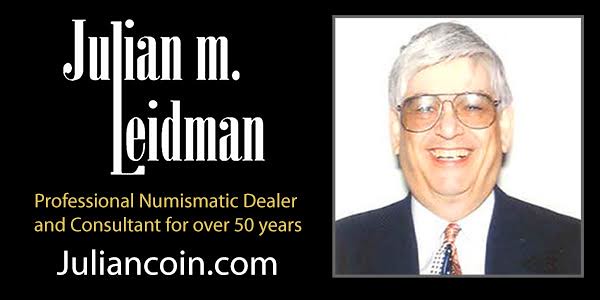
ANA REDESIGNS 2018 PHILADELPHIA MEDAL
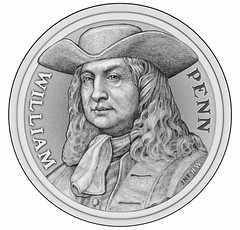

A revised commemorative medal design for the Philadelphia World’s Fair of Money was unveiled today by the American Numismatic Association. Designed by Jamie Franki and sculpted by noted medallic artist Heidi Wastweet, the reverse of the commemorative medal required a redesign after ownership questions surfaced around the famous Philadelphia LOVE graphic, which was originally depicted on the medal.
The reverse of the medal has been redesigned in the form of a Philadelphia love token, and features engraved elements from American paper currency that form a heart shape. The Eye of Providence, a quintessential engraved element from the dollar, forms the “o” in Love, and creates a tie to William Penn’s forward-thinking gaze depicted on the obverse. The love token, which has been engraved upon the surface of a reeded coin, also features the meaning of Penn’s “City of Brotherly Love” as it translates from the Greek.
On the obverse remains William Penn; English real estate entrepreneur, philosopher, early Quaker and founder of the British North American colony the Province of Pennsylvania.
“Love has likely been a subject for every known mode of human artistic expression,” said Franki. “One example of particular interest to numismatists is the tradition of the love token.”
Professor Jamie Franki currently teaches Illustration at the University of North Carolina at Charlotte, and he serves as a contributing designer for the United States Mint’s Artistic Infusion Program. Franki is a member of the American Medallic Sculpture Association, the ANA and the Charlotte Coin Club. In 2011, Franki received the ANA’s Presidential Award for his artistic practice and service to the numismatic community.
“Heidi Wastweet has sculpted thousands of masters for coins and medals and I knew her experience and insight would elevate this important commemorative into a true work of art,” said Franki. Wastweet serves the United States Mint as an elected medallic expert on the Citizen’s Coinage Advisory Committee. She also serves as the president of the American Medallic Sculpture Association.
The reverse of the commemorative medal originally featured the famous Philadelphia LOVE sculpture graphic created by artist Robert Indiana in 1964. When Indiana first created his art, he failed to properly file a copyright for LOVE, which has thrown ownership of the design into question. Indiana died on May 19. In light of newly surfacing questions about the estate proprietorship of Indiana’s LOVE designs and sculptures, Frank and the ANA opted to change the design out of respect to the late artist and his estate.
Medals are available as a convention medal badge (1.5” bronze medal with a ribbon drape) $20; bronze medal (2.75”) $65; or as a two-medal (1.5” bronze medal and 1.5” .999 FS medal, numbered) set for $100. Shipping is $6.95 per order.
Medals can be ordered by calling 800-514-2646. Attendees of the show can also purchase the medal at booth #99 in the Shop the ANA area.
To read the complete article, see:
World’s Fair of Money Commemorative Medal Redesign Represents Brotherly Love
(https://www.money.org/uploads/pdfs/ANA%20PR%20-%20WFM%20Philadelphia%20Medal%20Redesign.pdf)
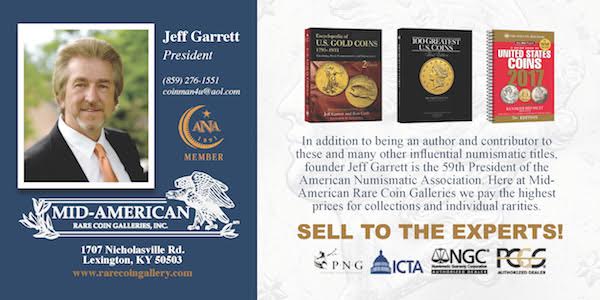
BIRMINGHAM WASHINGTON CENT REPLICAS STRUCK
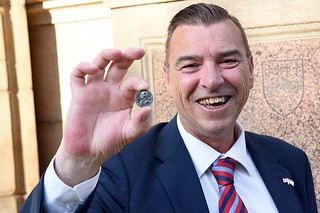 A commemorative coin produced in Birmingham will be presented to President Donald Trump after a university professor was inspired by a US reality TV show.
A commemorative coin produced in Birmingham will be presented to President Donald Trump after a university professor was inspired by a US reality TV show.
Professor Julian Beer, deputy vice-chancellor of Birmingham City University (BCU), was watching Pawn Stars, a show which centres on life at a Los Angeles pawn shop, when a rare coin called the Large Eagle Washington Cent featured.
Prof Beer said he found himself captivated by its history and Birmingham's connection to the coin.
He decided to have 400 coins reproduced by BCU's school of jewellery to give to delegates attending the British American Business Council (BABC) conference in Birmingham this week.
The first two commemorative coins minted are being presented to US Ambassador Robert Johnson at the conference's gala dinner tonight at Birmingham Town Hall, with one for him to pass on to President Trump.
All other delegates attending the conference will also be presented with the coin as a memento.
The coins were cast in pewter by the AE Williams family who are based in Digbeth and whose works features in TV shows such as Poldark and Game of Thrones.
They have been making the alloy since 1779.
The original Large Eagle Washington Cent was one of two coins commissioned in 1791 by Birmingham firm W and Alexander Walker and designed by engraver John Gregory Hancock.
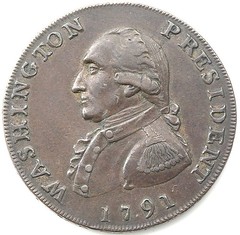
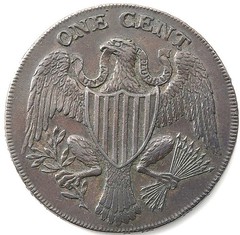
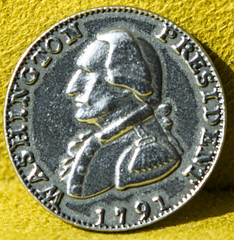
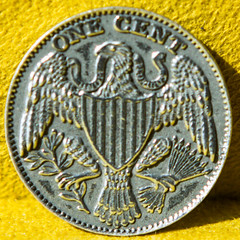
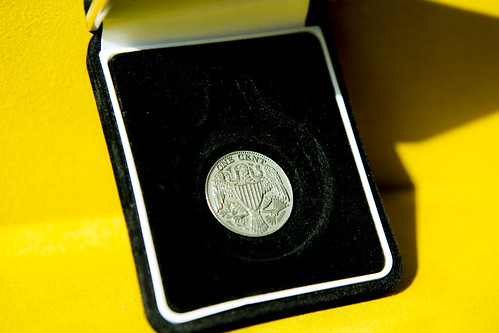
To read the complete article, see:
Birmingham City University makes historic coin for President Trump
(https://www.birminghammail.co.uk/news/midlands-news/birmingham-city-university-makes-historic-14755711)

HOW THE RAILROAD WARS SHAPED FINANCE TODAY
The feud seems like a classic Wild West story, a tale of masked, revolver-wielding horsemen on the frontier. In fact, it was one of the birth pains of America’s integrated financial system. The network of railroads was extensive enough in the 1860s to allow Congress to create a national bank system and a legal-tender paper currency to meet the demands of fighting the Civil War. There was no Federal Reserve yet, so banks connected by rail, sending bundles of cash across the country by express messenger. For bandits, it made sense to rob trains in the settled states, where there were more railroads carrying more money. As for Pinkerton, he filled a gap in interstate law enforcement, one that eventually led to the FBI. He took train robberies seriously; they cut into the arteries of the national economy. It was a lucky thing for banks that the bandits overreached in 1876 and never fully recovered.
In order to connect the Pacific Northwest with the rest of the United States, Congress had granted Northern Pacific a strip of land that, as historian Richard White writes, equaled the entire area of New England. The Lakota, also called the Western Sioux, claimed much of this terrain. Their resistance added to the railroad’s troubles, which sparked a panic on Wall Street later in 1873, ringing in one of the worst depressions in American history.
Today’s tech industry is not as far from 19th-century railroads as it may seem. Through their colorful rivalries, our world emerged. Vanderbilt battled Gould and Fisk in sophisticated financial markets that didn’t even exist when Vanderbilt was born. They developed new ways to structure corporate debt, shares and governance that are still in use. Our financial world, in which a payment in Portland is instantly accepted in Charleston, in which the savings of millions are redirected into productive loans, rose on a national railway network. Today the Federal Reserve has removed banks’ need to pay each other with physical cash, but express companies like Wells Fargo and American Express remain, having transformed from shippers of banknotes into lenders and financial institutions in their own right. Even the tragic Indian Wars speak to the role of the federal government in building the nation’s transportation infrastructure, much as it established the framework of the internet itself.
The hardware naturally draws our attention—locomotives, tracks, depots. It still matters, too; railroads carry 40 percent of America’s freight, a thriving legacy of that history. But railways also gave us our economic software, which we run day and night. They introduced large-scale business corporations, financial markets, an integrated banking system, a professional middle class—even time zones. It wasn’t all pretty, but the railroads so define our lives that it’s hard to imagine the world without them.
To read the complete article, see:
(http://www.amtrakthenational.com/a-journey-through-time-with-pulitzer-winning-historian-tj-stiles)
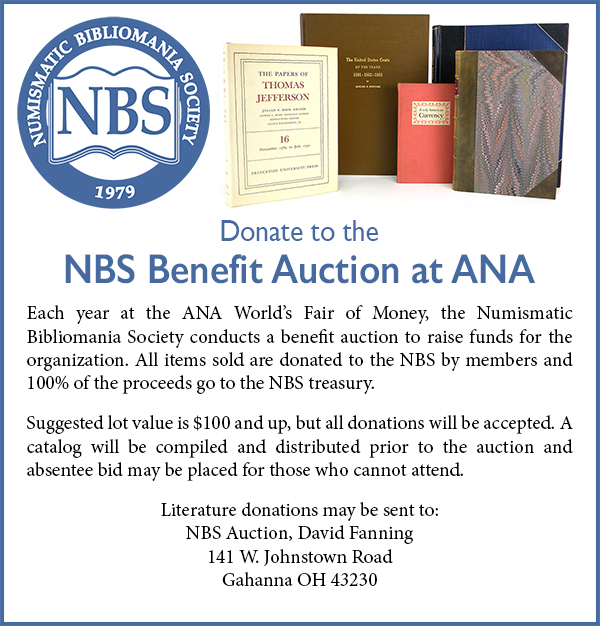
WWII CASH HOARD FOUND
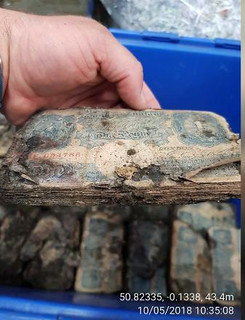 Construction workers in the UK have found wads of cash dating back to World War II at a shop that once belonged to a tailor beloved by Winston Churchill and his wife Clementine.
Construction workers in the UK have found wads of cash dating back to World War II at a shop that once belonged to a tailor beloved by Winston Churchill and his wife Clementine.
Stunned renovators pulled bundles of decaying, dirt-encrusted banknotes from their clandestine spot under a shop floor in the seaside city of Brighton in May.
The face value of the wartime pot totaled around £30,000 -- the equivalent of about £1.5 million (just over $2 million) today, once the Bank of England's official inflation rates have been factored in.
Sussex police have since taken the moldy £1 and £5 notes for "safekeeping," a spokesperson told CNN. It wasn't immediately clear who owns the premises where the money was found.
The site has since become a Cotswold Outdoor clothing retailer, but back between 1936 and 1973, it was a Bradleys Gowns store. Bradleys was a top London furrier and couturier set up in the 1860s.
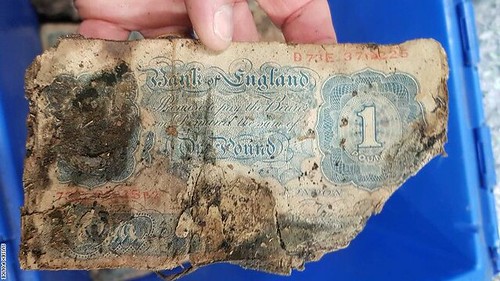
Howard Bradley is now the last remaining heir of the family name and the business, which has continued as a specialist dry cleaners in Milton Keynes, north of London.
He told CNN he was "shocked" but "very excited" when first contacted by a local reporter and informed of the historic discovery.
Bradley said he hasn't any ancestral tales alluding to the stashed cash but added that he wouldn't be surprised if someone had hidden some money away during the war.
To read the complete article, see:
WWII cash hoard found under floor of Churchill's tailor
(https://www.cnn.com/2018/06/08/europe/wwii-cash-discovery-intl/index.html)
The mystery of a cache of wartime banknotes found under a high-street shop deepened yesterday as a second family claimed possible ownership.
To read the complete article (subscription required), see:
Second family lays claim to stash of wartime banknotes
(https://www.thetimes.co.uk/edition/news/second-family-lays-claim-to-stash-of-wartime-banknotes-dx03wl6lj)
THE BOOK BAZARRE
WHERE IS BEALE'S TREASURE?
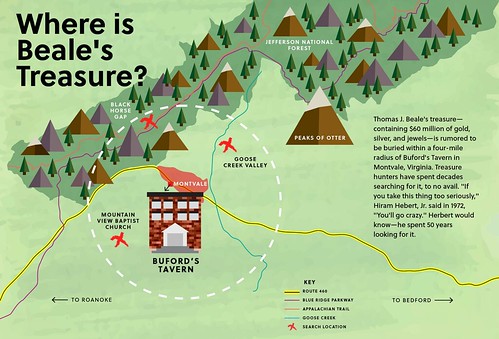
They come with metal detectors and magnetometers, Geiger counters and dowsing rods, backhoes and pickaxes, psychic mediums on speed dial and sticks of dynamite stuffed into their back pockets. They come motivated by a quirky Virginia state law that says buried treasure is finder’s-keepers (even if it’s discovered on private property). They come gripped by a monomaniacal belief that they—and only they—know where Beale’s treasure hides: the foothills, a farm, a cave, a grave, a cistern, a creek, an abandoned road. One treasure hunter insists it's buried at a local visitors’ center, right under the ladies room.
For these treasure hunters, a survey of the past 70 years of newspaper headlines shows a bleak pattern:
MAN HOT ON THE TRAIL OF THOMAS BEALE’S TREASURE.
FOLLOW-UP: MAN WRONG.
There’s the Chicago refrigeration contractor, certain he had broken the ciphers in five days, who convinced local officials to dig up a graveless patch of a cemetery, only to find clothes hangers (metal) and horseshoes (unlucky). There’s the Texas man who drove to Virginia, wife and kids in tow, simply to borrow a local roadmap that he believed would lead to the treasure. (It didn’t.) There’s the Massachusetts man who jumped out of bed, jolted by a dream, and drove bleary-eyed toward the Blue Ridge Mountains to test his prophecy. There’s the Oklahoma psychic who surveyed the Goose Creek Valley from a helicopter. There’s the Virginia Supreme Court Justice who scouted the location by bicycle; the Washington state man who hired armed guards; the anonymous man who kept an armored truck idling on a nearby road.
Beale treasure hunters are overwhelmingly male, though locals still chatter about one Pennsylvania woman, Marilyn Parsons, who cashed a disability check in 1983 and rented a backhoe to test her theory that the treasure was buried in an unmarked plot of a church graveyard. When she unearthed a coffin handle and human bones, she was arrested and advised to never step foot in Virginia again.
Like the Hart brothers, many treasure hunters trespass under starlight. In 1972, The Washington Post reported that local landowners regularly fired warning shots at strangers tip-toeing on their property. “People would sneak onto their land and blow big holes out of the ground and leave them that way. Cows would step in and break their legs,” Ed Easterling, a local Beale expert, says. “Most people here have resented it.”
Families have crumbled, bank accounts have evaporated, and jobs have disappeared. One man, Stan Czanowski, spent $70,000 over seven years on dynamite and bulldozers. In the early '80s, one treasure hunter bankrupted himself after blasting rocks for six months. (He abandoned town still owing the local motel money.) An editor at the American Cryptograph Association spent so much time focused on the ciphers that he was fired. The researcher Richard Greaves, who investigated the Beale story for decades, called it “possibly the worst decision I ever made. If I would have devoted all the hours spent pursuing this treasure legend to the study of medicine, I would easily have become an accomplished neurosurgeon.”
Which makes it all the more painful to consider that Beale’s treasure—the ciphers, the story, the gold, the silver, and the jewels, even Thomas J. Beale himself—might all be a big, fat hoax.
William F. Friedman, leader of the U.S. Army Signal Intelligence Service, or S.I.S.—the forerunner to the N.S.A.—spent his leisure hours attempting to untangle the Beale codes. He took them so seriously that his legal counselor drafted an agreement in case he solved them.
He never did, of course. In a letter, Friedman wrote: “So far as my attempts to produce an authentic reading is concerned, I can most earnestly say I have tried to the best of my ability and now must confess myself beaten.”
But Friedman never quit. Instead, he included the ciphers in the S.I.S training program. According to Frank Rowlett, an S.I.S. cryptologist who helped crack Japan’s PURPLE cipher machine during World War II, the trainees concluded the ciphers were phony. Friedman’s wife Elizebeth, also an accomplished cryptanalyst, dubbed them as a lost cause with a “diabolical ingenuity specifically designed to lure the unwary reader …. In fruitless research … or searching for a key book.” Friedman himself shrugged: “On Mondays, Wednesdays, and Fridays, I think it is real,” he said. “On Tuesdays, Thursdays, and Saturdays, I think it is a hoax.” (Sunday, it appears, was a day of rest.)
To read the complete article, see:
The Quest to Break America’s Most Mysterious Code—And Find $60 Million in Buried Treasure
(http://mentalfloss.com/article/540277/beale-ciphers-buried-treasure)
To read the earlier E-Sylum articles, see:
THE FAMOUS BEALE CIPHERS (http://www.coinbooks.org/esylum_v15n34a10.html)
MORE ON THE BEALE CIPHERS (http://www.coinbooks.org/esylum_v15n36a13.html)

MOVIE MEMORABILIA: FAKES AND AUTHENTICATION
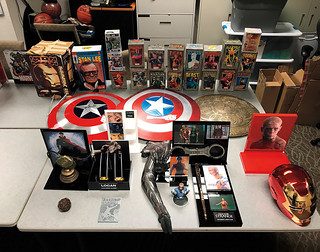 The untamed, boomtown realm of entertainment artifacts, especially the geekiest ones derived from studio productions and actors' personal estates, has become a potent business (with some auction house experts
estimating it has ballooned from $20 million to $40 million in annual sales a decade ago to $200 million to $400 million today). "I have hedge funds looking to diversify into this market," says Darren Julien, CEO
of Julien's Auctions.
The untamed, boomtown realm of entertainment artifacts, especially the geekiest ones derived from studio productions and actors' personal estates, has become a potent business (with some auction house experts
estimating it has ballooned from $20 million to $40 million in annual sales a decade ago to $200 million to $400 million today). "I have hedge funds looking to diversify into this market," says Darren Julien, CEO
of Julien's Auctions.
James Comisar, a collectibles consultant recognized for his authentication expertise, describes how, in an increasingly "seismic" market, collectors "with unlimited spending potential are trying to club each other to death" for a limited number of the most "iconic pieces — the pieces that you recognize from across the room, the ones that don't need a descriptive plaque, the instantly recognizable ones where you creep up to the display case, your voice drops, and you go, 'Holy shit!' " As a result, the hunt is always on for the next cache, and auction houses are constantly working relationships in the hope of securing the deaccession of a production's original materials or a star's personal property, the latter governed by the so-called Four D's of estate sales: death, divorce, debt and downsizing. "That's what I do all day," says Joe Maddalena, owner of Profiles in History, who has handled a series of sales of Debbie Reynolds' belongings before and after her 2016 death, grossing more than $25 million.
It's also a category in which larceny and fraud can flourish because some of the structural safeguards found in analogous markets like the fine art world and sports memorabilia scene have yet to materialize. In addition, law enforcement has generally taken thievery in those other sectors more seriously than cases in the entertainment collectibles realm.
Authentication is an unceasing trial in a milieu that traffics in visual deception in the first place. When clear provenance and chain of title can't be established, it's up to auctioneers and would-be buyers to ferret out frauds, whether purposeful or accidental, outsider efforts or insider cons, true "screen-used" pieces (the most prized) or indistinguishable alternates that may have been prepared for productions but ultimately never used in them (and bear far less value). "When you start selling Michael Jackson's gloves for $400,000, the forgers come out," says Julien, referring to his firm's 2009 sale.
Costume archivist Brown notes that one tack taken in recent years has been the incorporation of DNA into garments. "They document where it is on the costume," he says. Might one surmise that strands of hair are discreetly threaded into the costume? Brown won't reveal the exact nature of the trick. Who knows who will read this? And almost anything can be faked.
To read the complete article, see:
A Marvel Heist and the Booming Business (and Seedy Underworld) of Movie Collectibles
(https://www.hollywoodreporter.com/features/seedy-underworld-movie-memorabilia-1117268)
BOOKSELLERS ADAPT TO THE 21ST CENTURY
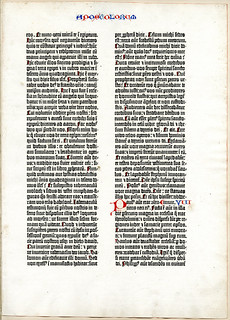 The rare book trade faces plenty of challenges. Unlike great robber-baron bibliophiles such John Pierpont Morgan and Andrew Carnegie, today’s super-wealthy prefer to build art collections rather than libraries. Art
has become a globalized alternative investment, generating a top-performing yield of 21 percent in 2017, according to the latest wealth report published by the realtors Knight Frank. Rare books do not feature in the report’s
basket of “luxury investments.”
The rare book trade faces plenty of challenges. Unlike great robber-baron bibliophiles such John Pierpont Morgan and Andrew Carnegie, today’s super-wealthy prefer to build art collections rather than libraries. Art
has become a globalized alternative investment, generating a top-performing yield of 21 percent in 2017, according to the latest wealth report published by the realtors Knight Frank. Rare books do not feature in the report’s
basket of “luxury investments.”
Dealers and auctioneers tend to refer to books instead as “stores of value,” reflecting a generally static price structure and customer base, which doesn’t excite alternative investors. As result, the rare book trade depends on knowledgeable collectors and institutions — and fellow dealers — to drive sales.
And there were sales at the A.B.A. fair, such as when Aquila Books of Calgary in Canada sold an 1871 first edition of Charles Darwin’s “The Descent of Man,” in which the author used the word “evolution” for the first time. Mr. Attenborough bought it, for £4,000.
Aquila, which specializes in exploration and evolution, made about £30,000 of sales at the A.B.A. fair, according to its founder, Cameron Treleaven. “I’m happy with that,” said Mr. Treleaven, who explained that fairs accounted about 40 percent of his annual sales, with another 35 percent generated through online trading.
“The arrival of the internet was the defining moment of my career,” added Mr. Treleaven. “It allowed us to find clients we never knew existed.”
Bernard Quaritch, for instance, took a rare single leaf from Gutenberg’s epoch-making 1450 Bible to the A.B.A.A. fair in New York and the A.B.A. one in London, priced at £100,000. It didn’t manage to sell at these fairs, but it is out there on the company’s Instagram account. As of Thursday the post had attracted 98 likes.
The dusty old book trade is evolving. Gradually.
To read the complete article, see:
Antiquarian Booksellers Adapt to the 21st Century (Gradually)
(https://www.nytimes.com/2018/06/01/arts/design/rare-books-internet.html)

THE MAN WHO WANTED TO BE A COIN
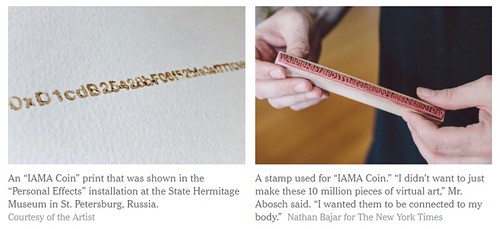
Kevin Abosch wanted to turn himself into a coin.
Why? Because he sold a photograph of a potato.
Let’s back up.
Mr. Abosch, 48, is an Irish conceptual artist and photographer who lives in New York. He is also interested in the blockchain, the technology best known for its use in virtual currencies like Bitcoin and ether. The strange culture surrounding these cryptocurrencies is increasingly making its way into art, in works that explore value, decentralization and the buzz around digital money.
Which brings us back to “Potato #345,” a photo that made headlines around the world after Mr. Abosch said it was purchased by a European businessman in 2015 for a million euros, or about $1.08 million. On the one hand, the attention generated by the sale was exciting, he said. “On the other hand, the focus shifts from the artistic value to monetary value of the work, and for most artists the art is an extension of the artist, so you yourself start to feel commodified,” Mr. Abosch said. “In order to sort of control that, I began to think of myself as a coin.”
Mr. Abosch turned to the blockchain, which essentially records a series of transactions across a large, open network of computers. The Ethereum blockchain allows coders to create virtual tokens, which can be transferred between users. They’re not always currencies, exactly, but something like them.
Mr. Abosch created 10 million tokens in January. “But I didn’t want to just make these 10 million pieces of virtual art,” he said. “I wanted them to be connected to my body.”
So, he had six vials of his blood drawn. He stamped the contract address — a long string of numbers and letters indicating where the tokens effectively live on the blockchain — onto 100 pieces of paper, in blood. And he called the project “IAMA Coin.” He said he believes that he has “successfully connected my physical body to the virtual works” in such a way that he sees the art “as pieces of me.”
Michael Connor, the artistic director of Rhizome, a center affiliated with the New Museum that aims to foster “digital-born art and culture,” said that he’s seen a flurry of crypto-related projects in the past year.
“You meet people in the crypto world who throw millions into coins backed by nothing, but don’t understand how a piece of art has any value,” he said. “Then you meet people in the art world who don’t understand why you would invest money in art that has no physical manifestation. That’s where it gets exciting for me.”
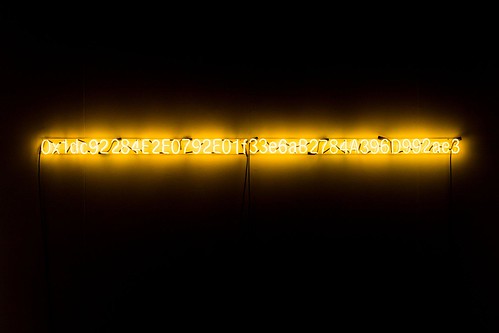
“YELLOW LAMBO” (2018), a neon sculpture of a blockchain address symbolizing Lamborghinis, sold to a former Skype executive for $400,000.
He has a foot in both the art and tech worlds, and experiments with their intersection; while he works, Mr. Abosch has been wearing an electroencephalogram, or EEG cap, which can measure electrical activity in the brain. He wrote in an email that this is “an attempt to understand to what extent ego is engaged or how it colors work, particularly when I’m photographing humans.”
“I think that it’s such a weird field at the moment, so art is evolving really quickly in response to it,” Mr. Connor said.
Mr. Abosch, meanwhile, is tokenizing Manhattan. For a soon-to-be-unveiled project, he has created 10,000 blockchain tokens for every street in Manhattan, then printed the contract addresses on a 6-foot-tall map. This month, collectors will be able to buy the tokens, or virtual artworks, for a few dollars each. More projects are on the way.
“Whatever this is,” Mr. Abosch said, “I’m right in the middle of it.”
To read the complete article, see:
When Crypto Meets Conceptual Art, Things Get Weird
(https://www.nytimes.com/2018/06/05/arts/design/cryptocurrency-blockchain-art-kevin-abosch.html)
IN OTHER NEWS: JUNE 10, 2018
When Numismatics Hits the Mainstream
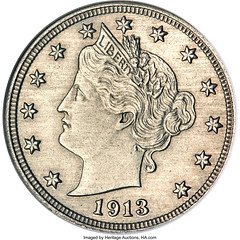 It’s a great feeling to be watching the evening news, or reading a newspaper (I still do), or scrolling through news websites and suddenly see — or hear — a story about the latest rare coin auction. It’s that same
vibe of excitement you probably get if you’re from a small town that for whatever reason makes it into the national news… For positive reasons, you hope! Having family ties to Braintree, Massachusetts, it gives me the
“feels” when I’m checking out the news from my Florida home and the name of that small Boston suburb gets a shout-out in the story — especially when it’s good news.
It’s a great feeling to be watching the evening news, or reading a newspaper (I still do), or scrolling through news websites and suddenly see — or hear — a story about the latest rare coin auction. It’s that same
vibe of excitement you probably get if you’re from a small town that for whatever reason makes it into the national news… For positive reasons, you hope! Having family ties to Braintree, Massachusetts, it gives me the
“feels” when I’m checking out the news from my Florida home and the name of that small Boston suburb gets a shout-out in the story — especially when it’s good news.
And that’s about how it is for me when a “good” numismatic story pops up in my newsfeed from a major news network such as CNN or the Huffington Post. It happened just the other day when FOX reported on the 1913 Liberty nickel. “A $5 Million Nickel?” the headline asks… “Extremely Rare 1913 Coin Up for Auction” continues the story’s banner.
Sure, to the numismatist’s mind, there is the predictable narrative that follows. We know it’s a story about the 1913 Liberty nickel. And we know there will be soooooooo many juicy details (provenance, please!) about the coin that we collectors want to know but will be glossed over in the story so as not to bore non-numismatic readers. And we’re further aware that what might follow is a litany of comments from lay readers who think they themselves have a 1913 Liberty nickel, of which there are just five known — all accounted for… “I got 2 of these from my grandfather,” someone will write. There will also be a bunch of questions about the value of other coins. “Whats my 1956 nickle worth” will assuredly ask another (misspelling and lack of proper punctuation in the example intended here).
You know what? This is good. It’s good for the hobby. For every predictable headline about the sale of a 1787 Brasher Doubloon, 1804 dollar, or 1913 Liberty nickel are at least a few folks who are learning for the first time that some coins are worth a lot of money and that, yes, coins really are cool. Many folks will start checking their change – in vain, we know – for these featured rare coins. Maybe they will find a few wheat cents or other interesting coins to help keep the interest of these treasure seekers. How many new coin collectors will each of these stories eventually generate?
To read the complete article, see:
When Coins Break Into Mainstream News Headlines (http://blog.greysheet.com/when-coins-break-into-mainstream-news-headlines/)
1964 Treasury Silver Dollar Bags To Be Sold
 A hoard of 16,000 Morgan dollars stored in canvas bags in a New York City bank vault since their purchase in 1964 from the Treasury Department stockpile will be placed on the market after all are graded and slabbed
by Numismatic Guaranty Corp.
A hoard of 16,000 Morgan dollars stored in canvas bags in a New York City bank vault since their purchase in 1964 from the Treasury Department stockpile will be placed on the market after all are graded and slabbed
by Numismatic Guaranty Corp.
Jeff Garrett, founder and president of Mid-American Rare Coin Galleries in Lexington, Kentucky, will be offering the coins in the hoard.
Garrett said the son and daughter of the man who originally purchased the coins more than 50 years ago no longer wanted to continue paying the $800 annual rental fee for the roughly 3-foot by 3-foot by 4-foot safe-deposit box that houses the silver dollars.
The coins in the hoard were contained in 16 canvas bags of 1,000 coins each, with each bag comprising coins of a specific date and Mint production facility.
To read the complete article, see:
Hoard of 16,000 Morgan silver dollars to be graded, marketed
(https://www.coinworld.com/news/us-coins/2018/06/silver-dollar-hoard-from-1960s-government-sale.html)

